

Index
Note to the Reader: Throughout this index boldfaced page numbers indicate primary discussions of a topic. Italicized page numbers indicate illustrations.
NUMBERS
2B+D service, 528 4B/5B encoding, 528
8/125 optical fiber, 338–339, 339 8B/10B encoding, 528
8B6T encoding, 528
10Base-2 networks, 127–128, 127 10Base-5 networks, 124 10Base-F networks, 125–127
10Base-T networks, 123–125, 126 color-coding for, 414
pin assignments for, 312 Y-adapters for, 313, 313 10Mbps Ethernet networks 10Base-2, 127–128, 127
10Base-F, 125–127 10Base-T, 123–125, 126
19-inch racks, 191–192, 192–193
25-pair wire assignments, 266, 267–268 50/125 optical fiber, 339
50-pin Telco connectors, 262, 262, 528 62.5/125 optical fiber, 339, 340
66punch-down blocks, 196–197, 196, 528 for telephone, 388–389, 390
for voice applications, 264–266, 264–268, 270, 270–271
100-ohm UTP cabling, 92–93 100Base-FX networks, 131 100Base-T4 networks, 129–130, 130 100Base-TX networks, 129, 312 100Mbps Ethernet networks, 129
100Base-FX, 131 100Base-T4, 129–130, 130 100Base-TX, 129
100VG-AnyLAN networks, 139–140
110 punch-down blocks, 197, 197, 407, 407, 528 for copper cable, 258–261, 258–261 terminations in, 298, 299
568A wiring, 414 1000Base-CX networks, 133 1000Base-LX networks, 132 1000Base-SX networks, 132 1000Base-T networks, 14, 133
1394 Trade Association, 632–633
A
A ports in FDDI, 136, 136 A-to-B cables in USB, 636 abbreviations, 30 abrasion marks, 528 absorption, 528
abstract syntax notation (ASN) 1, 528 AC (alternating current), 530 acceptance angle
defined, 528
as performance factor, 346, 346 acceptance cones, 528
acceptance in RFPs, 501 acceptance patterns, 529 access couplers, 529 access floors, 100
access methods, 529 accountability in RFPs, 499
ACK (acknowledgement) messages, 529
ACR (attenuation to crosstalk ratio), 57–58, 58 in copper cable performance, 454
defined, 532
active branching devices, 529 active couplers, 529
active laser medium, 529 active monitors, 529 active splicing, 529
ad hoc RF networks, 364, 364 adapters, 87–88, 529–530
Address Resolution Protocol (ARP), 146, 531–532

660 addresses—attenuation
addresses defined, 530 IP, 147
adhesives, 322
adjustable attenuators, 530 administration, 530
administration standards for telecommunications rooms,
201–202
ADSL (Asymmetric Digital Subscriber Line), 532 Advanced Intelligent Network (AIN), 530 advisories, 76
aerial cable, 530
AIN (Advanced Intelligent Network), 530 air polishing, 440
air space wiring, 165 air terminals, 163
Aironet RF networking product, 366 AirPort RF networking product, 366 Alco wipes, 435
alignment
of fiber optic connectors, 321
in infrared transmissions, 350–351, 351 Alohanet, 121
alternating current (AC), 530 AM (amplitude modulation), 530 ambiguities, clarifying, 512
American National Standard T1.523–2001 site, 610 American National Standards Institute (ANSI), 65–66, 530.
See also TIA/EIA-568-B standard; TIA/EIA-569-A standard
American Society for Testing and Materials (ASTM), 532 American Standard Code for Information Interchange
(ASCII), 530 American Wire Gauge (AWG)
defined, 530 table of, 34–35
amperes, 530
amplifier probes, 219, 220, 273, 273 amplifiers, 530
amplitude, 530
amplitude modulation (AM), 530 anaerobic-curing, 322
analog signals, 530 analog-to-digital converters, 531 ANDing, 147–148
angle of incidence, 531 angle of reflection, 531 angle of refraction, 531 angled ends, 531
angled faceplate modules, 182, 182 angled jacks, 292, 292
angled physical contact (APC) connectors, 531 angular misalignment, 531
animal damage, 252
Anixter Cable Performance Levels Program, 8–9, 106–109 Anixter company, 614
Anixter Levels XP, 9
ANSI (American National Standards Institute), 65–66, 531. See also TIA/EIA-568-B standard; TIA/EIA-569-A standard
ANSI X3T9.5 TP-PMD standard, 310, 312 antennas, 358, 359
antireflection (AR) coating, 531
APC (angled physical contact) connectors, 531 APDs (avalanche photodiodes), 533
APL (average picture level), 533 appearance hints and guidelines, 515 AppleTalk protocol, 147, 531 applications
defined, 8, 531 demands of, 10
AR (antireflection) coating, 531 aramid yarn, 531
as strength member, 337 trimming, 209, 210, 430–431, 431
ARCnet (Attached Resource Computer network), 531 armoring, 531
ARP (Address Resolution Protocol), 146, 531–532 as-built documentation, 500, 508
ASCII (American Standard Code for Information Interchange), 530
ASN (abstract syntax notation) 1, 528
ASTM (American Society for Testing and Materials), 532 Asymmetric Digital Subscriber Line (ADSL), 532 asynchronous modes in IEEE 1394 networking, 635 asynchronous transmissions, 532
ATM (asynchronous transfer mode) networks, 137–139, 139, 532
ATM Forum, 72 ATM Forum site, 139
ATM Physical Medium Dependent Interface Specification, 72
atmospheric attenuation, 371
Attached Resource Computer network (ARCnet), 531 attachment unit interface (AUI), 122, 532 attenuation, 532
in copper cable, 276, 453 and decibel values, 42–46 in fiber optic cabling
in installation, 345–346, 345 testing, 222, 222, 457–458
as high-speed limitation, 48–50, 49

attenuation-limited operations—BICSI |
661 |
in IEEE 1394 networking, 634 in infrared transmissions, 355
broadcast, 354 point-to-point, 352–353
in microwave communications, 371 satellite, 370
terrestrial, 368
in modular patch cables, 180 in RF systems
high-power, single-frequency, 361 low-power, single-frequency, 360 spread-spectrum, 363
of solid vs. stranded wire, 36 troubleshooting, 477–478 attenuation-limited operations, 533
attenuation testers, 222, 222
attenuation to crosstalk ratio (ACR), 57–58, 58 in copper cable performance, 454
defined, 532 attenuators, 533 audio frequencies, 533
AUI (attachment unit interface), 122, 532 authority for projects, 487
auxiliary AC power, 533
avalanche photodiodes (APDs), 533
Avaya SYSTIMAX SCS Cabling System, 112 average picture level (APL), 533
average power, 533 average wavelength, 533
AWG (American Wire Gauge) defined, 530
table of, 34–35 axial rays, 533
B
B-channel (bearer channel), 535 B ends in USB, 636
B ports in FDDI, 136, 136
backbone cabling, 178–180, 179, 533 in cable category performance, 92 distances for, 87
media for, 87
in RFPs, 489, 493, 505 TIA/EIA-568-B standard for, 84–87, 86 TIA/EIA-569-A standard for, 101–102 UTP cabling, 242–244
backbones, 381–382, 382, 533 backscatter, 470–471, 471, 533
backscatter coefficient, 470 balance, 533
balanced cables, 533 balanced couplers, 534
balanced signal transmissions, 51, 534 baluns, 135, 534
band color, 239, 239 bandpass range, 534 bandwidth, 38–42, 39–41, 534
with bridges, 146
of cable categories, 92 of fiber optic cable, 17 with hubs, 142–143
of infrared transmissions, 354
in microwave communications, 370 of UTP cable, 13–14
bandwidth-limited operations, 534 barrier layers, 534
base color, 239, 239 baseband networks, 123, 534
baselines for troubleshooting, 474 basic rate interface (BRI), 534
batteries in standby power supplies, 395 battery distribution fuse bays (BDFBs), 534 baud, 534
BD code, 105
BDFBs (battery distribution fuse bays), 534 BDs (building distributors)
defined, 537
ISO/IEC 11801 standard for, 105 beacon frames, 534
bead chains, 226
beam antennas, 358, 359 beamsplitters, 534 beamwidth, 535
bearer channel (B-channel), 535 BEF code, 105
bel unit, 43, 535
Bell, Alexander Graham, 11, 43 bend loss, 535
bend radius, 535
angled faceplate modules for, 182 in copper cabling, 254
in pulling cable, 405, 405
bends in optical fiber cable, 186–187 BER (bit error rate), 535
Berk-Tek company, 614
BERTs (bit error rate testers), 535 biconic connectors, 535
BICSI (Building Industry Consulting Services International), 72, 537, 616

662 BICSI conference—cable management
BICSI conference, 620 bidding process in RFPs, 508
bidirectional attenuation testing, 495 bidirectional couplers, 535 bifurcated contact prongs, 265, 265 binder groups, 244, 535
binders, 535
biscuit jacks, 294, 294 advantages of, 295–296, 296 disadvantages of, 296
types of, 295, 295 bistable optics, 535
bit directional tool, 227, 228 bit error rate (BER), 535
bit error rate testers (BERTs), 535 bit streams, 535
bit stuffing, 536 bit time, 536 bits, 535
bits per second (bps), 40, 536 BL color, 536
black bodies, 536 blind spots, 467–468 blown fiber, 536 BNC connectors, 536
10Base-2 Ethernet networks, 127–128, 127 for coaxial cable, 317, 317
Boggs, David, 121
bonding, 161, 163–164, 173, 536 books, 610–612
bounce, 355 bounded media, 536
bps (bits per second), 40, 536 BR color, 536
braid, 536
braided shielding, trimming, 424, 424 break-out cables, 536
break-out kits, 536 breaker boxes, 196 breaks, locating, 450–451
BreezNET RF product, 366 BRI (basic rate interface), 534 bridge taps
in backbone cabling, 86 defined, 536
bridges, 144–146, 144–145 defined, 536
wireless, 364–365, 365 broadband ISDN, 537
Broadband Local Area Networks standard, 560 broadband networks, 123
broadcast transmissions defined, 537
infrared, 353–354, 353 brouters, 537
Bucket Bag, 233, 233 buffer tubes, 537
buffers for fiber optic cable, 18, 19, 335–336, 336 defined, 537
stripping, 431, 432 building cable, 537 building distributors (BDs)
defined, 537
ISO/IEC 11801 standard for, 105 building entrances, 537
Building Industry Consulting Services International (BICSI), 72, 537, 616
Building Your Own High-Tech Small Office, 611 bundled cable, 537
in telecommunications rooms, 201 UTP, 242–244
bundles, 537
bus topologies, 118–119, 118, 379–380, 538 business knowledge, 511
busy tokens, 133
buy-in for RFPs, 486–487 bypassing, 538
bytes, 538
C
c symbol, 538 C symbol, 538
C-UL marks, 155–157
cabinets, 194, 194, 628–630, 628–629 cable, 538
cable area networks (CANs), 539 cable assembly, 538
cable certification reports, 500 cable crimpers, 210
coaxial, 212, 213, 214 fiber optic, 436–437
twisted-pair, 210–211, 211–212, 412, 415, 416 cable ducts, 538
cable entrance conduits, 538
cable entrance facilities (CEFs), 538 cable hangers, 194
Cable Installation and Maintenance magazine, 611 cable management, 538
accessories for, 194, 195
in copper cable installation, 253

cable modems—cells in ATM 663
cable modems, 538
Cable Performance Levels, 8 cable plant certification, 458–459
for copper cable, 460–462 for fiber optic cable, 462–463 testing regiments in, 459–460 third-party, 463
cable plants defined, 538–539
in RFPs, 504–508 cable pulleys, 224, 224
cable pulling, 404–406, 405
in copper cable installation, 254–255, 255 lubricant for, 228–229, 229, 402
tools for, 223–227, 224–228 Cable Pulling video, 611
cable rearrangement facility (CRF), 539 cable scanners, 587
multifunction, 472–473 for opens and shorts, 477 for patch cables, 475
cable sheath, 27, 539, 588 cable spool racks, 401, 401 cable strippers, 417, 423
cable testers. See TDRs (time domain reflectometers) cable testing tools. See tools
cable toners, 218–219, 219–220 cable tracers, 472
cable trays, 183–184, 184–185, 393, 393 cabletesting.com site, 609
Cabling Business Magazine, 611
cabling closets. See telecommunications rooms Cabling Installation and Maintenance magazine, 611 cabling maps, 406
cabling newsgroup, 608
cabling racks. See racks and enclosures CADDY CatTrax cable tray, 184, 185, 614 campus, 539
campus backbones, 539 campus distributors (CDs)
defined, 539
ISO/IEC 11801 standard for, 105 CANs (cable area networks), 539 capacitance, 38, 50, 539
capacitance unbalance, 51 capacity
in infrared transmissions broadcast, 354 point-to-point, 353
in microwave communications satellite, 370
terrestrial, 368
in RF systems
high-power, single-frequency, 361 low-power, single-frequency, 360 spread-spectrum, 363
carrier detect (CD) circuits, 539 carrier sense method, 539
Carrier Sense Multiple Access/Collision Avoidance (CSMA/CA), 539
Carrier Sense Multiple Access/Collision Detection (CSMA/CD) method, 121
defined, 539 with hubs, 142
carriers, 539 case studies
inside job, 524–525 large job, 521–522 peculiar job, 523 small job, 519–520
categories of cable, 13–14 attenuation values of, 49 bandwidth of, 92 Category 1, 238, 539 Category 2, 238, 539 Category 3, 238, 240, 540 Category 4, 240, 540
Category 5/5e, 240–241, 540 Category 6, 241
defined, 540 standards for, 494
Category 7, 540
copper testing in, 460–463 NEXT values for, 57–58
CatTrax cable tray, 184, 185
CATV (community antenna television), 543 CC Dockets, 153
CCIA (Computer Communications Industry Association), 73
CCITT (International Telephone and Telegraph
Consultative Committee), 71, 563 CD (carrier detect) circuits, 539
CD code, 105
CDDI (Copper Distributed Data Interface) architectures, 137, 545
CDMA (code division multiple access), 543 CDs (campus distributors)
defined, 539
ISO/IEC 11801 standard for, 105 CECs (Continuing Education Credits), 620 CEFs (cable entrance facilities), 538 ceiling pathways, 101
cells in ATM, 137–138

664 center wavelengths—common electrical service
center wavelengths laser, 540 LED, 540
central members, 540 central office (CO), 540–541
central office ground bus, 541
CEPT (Conference of European Postal and Telecommunications Administrations), 544
certification for copper cable, 274 certification programs
CFOI program, 645–651 DCIC program, 640–645 FOT program, 651–657
RCDD. See RCDD (Registered Communications Distribution Designer) certification
certification tools, 472
CEV (controlled environmental vault), 544
CFOI (Certified Fiber Optics Installer) requirements,
645–651 chains, 226 channel banks, 541
channel insertion loss, 541 channel link
vs. permanent link, 84–85 testing, 460–462
channel service unit/digital service unit (CSU/DSU), 541 channels, 541
characteristic impedance, 541 Charles Spurgeon's Ethernet site, 610 cheapernet, 541
cheater brackets, 284–285, 284–285 chips in direct frequency modulation, 361 chromatic dispersion, 348, 348, 541 churn, 541
CIR (committed information rate), 543 circuits, 541
cladding, 18, 19, 331–332, 332, 541 cladding mode, 542
Class A cable, 106, 542 Class B cable, 106, 542 Class C cable, 106, 542 Class D cable, 106, 542 Class E cable, 106, 542 Class F cable, 106
cleanup, hints and guidelines for, 518 clearance space requirements, 160 cleaving, 542
closets, 542. See also telecommunications rooms CM markings, 174–175
CMG marking, 30 CMR marking, 30
CO (central office), 540–541 coating, 542
coaxial cable, 21–22, 22, 244–245, 244, 542 in 10Base-2 networks, 127
in bus topologies, 118 crimpers for, 212, 213, 214 grounding, 129, 244
in new standards, 87 for television, 385
testing tools for, 220, 221
wire strippers for, 207–208, 207–208 coaxial cable connector installation, 421
connector types for, 421–422, 422 crimping procedures for, 422–426, 423–425 testing, 426
coaxial cable connectors, 315 BNC, 317, 317
F-series, 316, 316
N-series, 316, 316 TV, 422, 422
code division multiple access (CDMA), 543 codes, 152
FCC, 152–153 and law, 157–158
NAFE, 153–155
NEC. See NEC (National Electrical Code) UL, 155–157
coherence, 543
coherence length and time, 543 coherent communications, 543 coherent light, 543
collisions, 543
CSMA/CA for, 121, 142, 539 with hubs, 142, 142
color and color codes
for backbone cable, 242–244 for horizontal cable, 83–84 marking supplies for, 229–230
for modular jacks and plugs, 305–306 for T568A and T568B wiring, 81–83 for telecommunications rooms, 201 for UTP cable, 239–240
for wire insulation, 31–33
Commercial Building Grounding and Bonding Requirements for Telecommunications standard,
102–103
Commercial Building Telecommunications Cabling Standard. See TIA/EIA-568-B standard
committed information rate (CIR), 543 common abbreviations, 30
common electrical service, 161

common mode transmission—copper cable installation |
665 |
common mode transmission, 543 communications media types, 11 coaxial cable, 21–22, 22
fiber optic cable, 16–19, 19–21 twisted-pair cable, 11–16, 12, 15–16
communications systems, NEC code for, 169–176 community antenna television (CATV), 543 comp.dcom.cabling site, 608
completion dates in RFPs, 497 compliance, 543
components
in Anixter Cable Performance Levels Program, 108–109 crosstalk from, 478
composite fiber, 167
Computer Communications Industry Association (CCIA), 73 concatenation, 543
concatenation gamma, 543 concentrators, 543. See also hubs concrete-encased electrodes, 162 conductive fiber, 167 conductivity, 543
conductors, 543 grounding, 161, 172
NEC code for, 160–164, 172 resistance of, 50
solid vs. stranded, 36–37
in twisted-pair cable connectors, 414–415 conduits, 100–101, 183, 392–393, 543–544
attenuation from, 49
for metal boxes, 282, 283
Conference of European Postal and Telecommunications Administrations (CEPT), 544
conference rooms in RFPs, 492 connecting blocks, 544 connection-oriented protocols, 544 connectionless protocols, 544
connections for modular wall plates, 291–292, 291 connectivity devices, 140
bridges, 144–146, 144–145 hubs, 141–143, 141–143 repeaters, 140–141, 140 routers, 147–149, 148 switches, 147
connector-induced optical fiber loss, 544 connector installation
coaxial cable, 421–426, 422–425
fiber optic cable. See fiber optic cable connector installation
twisted-pair cable. See twisted-pair cable connector installation
connector panels, 199, 200
connector plugs, 544 connector receptacles, 544 connector variation, 544 connectorization, 406, 412
connectors, 181–182, 182, 298, 544
for 10Base-2 networks, 127–128, 127 coaxial cable, 315–317, 316
fiber optic cable. See fiber optic cable connector installation in home cabling, 627
in IBM cabling system, 111, 111 in IEEE 1394 networking, 634 for solid vs. stranded wire, 36
twisted-pair cable. See twisted-pair cable connectors in USB, 636, 637
consolidation points (CPs), 199, 200, 544 consumables kit, 544
contingencies, planning for, 515–517 Continuing Education Credits (CECs), 620 continuity, 544
continuity testers, 465 for copper cable, 273
for optical fiber, 221–222, 221 for twisted-pair, 219–220, 221
contractor requirements section in RFPs, 502 controlled environmental vault (CEV), 544 copper cable, 236
benefits of, 247–248
cable plant certification for, 460–462 coaxial, 244–245, 244
hybrid, 245
installing. See copper cable installation NVP value of, 37, 275
patch cables, 245–246 problems with, 275–276 STP, 241, 242
testing. See copper cable tests types of, 236–237
UTP categories, 238, 240–241
for voice applications, 264–272, 264–272 copper cable installation
110-blocks for, 258–261, 258–261 distances in, 249, 250 interference in, 257–258 planning, 251–252
pulling cable in, 254–255, 255
sample, 261–263, 262–263, 268–272, 270–272 sheath sharing in, 256–257
standards for, 248–251, 250–252 tips for, 253–254
voice and data patch panel separation in, 255, 256 wiring patterns in, 249–251, 251

666 copper cable tests—cut-in wall plate mounting
copper cable tests, 272–276, 273–274, 446–447 length, 449–451
performance ACR in, 454
attenuation in, 453 FEXT in, 454 impedance in, 452–453
NEXT in, 453–454, 453–454 noise, 455
propagation delay and delay skew in, 455 wire mapping, 447–449, 447–448
Copper Distributed Data Interface (CDDI) architectures, 137, 545
core, 36, 101, 545
of coaxial cable, 21
of fiber optic cable, 18, 19, 331–332, 332
core/cladding sizes of fiber optic cabling, 338–339, 339–340 core eccentricity, 545
cost
in design, 378
of fiber optic cable, 18, 329 in infrared transmissions, 354
broadcast, 354 point-to-point, 352
in microwave communications, 371 satellite, 370
terrestrial, 368 in RF systems
high-power, single-frequency, 360 low-power, single-frequency, 360 spread-spectrum, 362
of tools, 205
counter-rotating arrangements, 545 couplers, 478, 545
coupling, 545
coupling efficiency, 545 coupling loss, 545 coupling ratio/loss, 545
cover-plate mounting brackets, 284–285, 284–285 CPs (consolidation points), 199, 200, 544
CRC (cyclic redundancy check), 546 CRF (cable rearrangement facility), 539 crimp-on connectors, 422
crimp sleeves, 429, 436–437 crimpers, 210, 420, 420
coaxial, 212, 213, 214 fiber optic, 436–437
twisted-pair, 210–211, 211–212, 412, 415, 416 crimping, 412
for coaxial cable connectors, 422–426, 423–425 for fiber optic connections, 322
for modular wall plates, 291
for twisted-pair cable connectors, 415–421, 416–421 Crimplok connector system, 427
Crimpmaster Crimp Tool, 212, 213 critical angle, 545
critter damage, 252 cross-connect blocks, 92
cross-connect devices, 85, 196, 545 in cable category performance, 92 consolidation points, 199, 200
fiber optic connector panels, 199, 200 limitations, 93
modular patch panels, 198–199, 198–199 punch-down blocks, 196–197, 196–197
cross-connections, 545 crossed pairs, 448, 448 crossover, 545 crossover cable
defined, 545
for modular jacks and plugs, 314 crossover wiring, 415
crosstalk, 51, 52, 546 ACR ratio, 57–58, 58
in copper cable, 275, 453–454 in copper testing, 461–462 equal-level far-end, 53–54 far-end, 53
in fiber optic cabling, 328 in modular patch cables, 180 near-end, 52–53, 53 pair-to-pair, 54, 55
power sum, 54, 55 troubleshooting, 478
crush impact test, 546 CSA International, 71–72 CSA marking, 30
CSMA/CA (Carrier Sense Multiple Access/Collision Avoidance), 539
CSMA/CD (Carrier Sense Multiple Access/Collision Detection), 121
defined, 539 with hubs, 142
CSMA/CD Networking standard, 560
CSU/DSU (channel service unit/digital service unit), 541 CT faceplates, 182, 182
curing ovens, 438 current, 546
current technology, understanding, 510 curvature loss, 546
customer premises, 546
cut-in wall plate mounting, 282–285, 283–285

cut-through resistance—digital technologies |
667 |
cut-through resistance, 546 cutback method, 546 cutoff wavelength, 546
cutover in project administration, 500–501 cutting fiber optic cable, 429–430, 429–430 cycles per second, 38, 39, 546
cyclic redundancy check (CRC), 546
D
D-channel, 548 D-rings, 394, 395 D-type connectors, 551
DACs (dual attachment concentrators), 551 daisy chain method, 547
dark current, 547 dark fiber, 19, 547
DASs (dual-attached stations), 136–137, 551 data and voice patch panel separation, 255, 256
Data-Cabling Installer Certification (DCIC) program,
640–645
data communication equipment (DCE), 547 data communications, 38
bandwidth, frequency, and data rate in, 38–42,
39–41 decibels in, 42–46 encoding in, 41–42, 41
data-grade cable, 547 data packets, 547
data rate, 38–42, 39–41 defined, 547
in fiber optic cabling, 328 data-ready homes, 103
data security. See security
data terminal equipment (DTE), 547
Data Transmissions Systems and Equipment committee, 67 datagrams, 547
dB (decibels), 42, 548 example, 46
and power, 43–46 DB-9 connectors, 547 DB-15 connectors, 547 DB-25 connectors, 547 DC (direct current), 549 DC loop resistance, 547
DCE (data communication equipment), 547
DCIC (Data-Cabling Installer Certification) program,
640–645
DECconnect system, 112–113
decibels (dB), 42, 548 example, 46
and power, 43–46 definitions in NEC code, 159 degenerate waveguides, 548
delay and delay skew, 31, 58–59, 59, 548 in copper cable performance, 455
in copper testing, 461–462
in microwave communications, 371 delta, 548
demand priority, 129, 548
Demand Priority Access Method standard, 561 demarcation points, 89, 90
defined, 548
in home cabling, 627 demultiplexing, 548 descriptions in RFPs, 499 design, 22–24, 376
cable jackets, 27–30, 28
ease of administration in, 378 flexibility in, 377, 493 infrastructure, 493–496
in installation, 376–378, 398–399 longevity in, 377
plenum, 24–26, 24 riser, 26–27
solid conductors vs. stranded in, 36–37 standards and performance characteristics in, 377 twists in, 34
wire insulation in, 30–33 detector noise limited operations, 548 detectors, 468, 548
diameter mismatch loss, 548 dichromatic filters, 549 dielectric constants, 50, 549 dielectric loss, 549 dielectric material, 30, 549
dielectric nonmetallic materials, 549 dielectric properties, 12
differential mode attenuation, 549 differential mode transmission, 549 diffraction, 549
diffraction grating, 549 diffuse infrared signals, 354 digital loop carrier, 549
digital multimeters (DMMs), 451 digital signal (DS), 549
digital signal cross-connect (DSX), 549 digital subscriber line (DSL), 550 digital technologies, 549

668 diodes—electrode grounding
diodes, 550
laser, 351, 566
LEDs, 94, 326–327, 566 direct current (DC), 550
direct frequency modulation, 361, 361 direct inside wire (DIW), 550 disconnecting systems, 161 dispersion, 550
chromatic, 348, 348 modal, 347, 347
dispersion flattened fiber, 550 dispersion limited operations, 550 dispersion shifted fiber, 550 dispersion unshifted fiber, 550 distances
in backbone cabling, 87
in copper cabling, 249, 250 in fiber optic cabling, 328 in horizontal cabling, 79–80
in IEEE 1394 networking, 633–634 in microwave communications, 371 in RF systems, 364
in USB, 636 distortion, 550
distortion-limited operations, 550
Distributed Queue Dual Bus (DQDB) Metropolitan Area Network standard, 560
distributing RFPs, 498–499 distribution panels, 343 distribution subsystems, 550 disturbed pairs, 52
DIW (direct inside wire), 549 DIX connectors, 122
DMMs (digital multimeters), 451 DNPs (dry nonpolish connectors), 551 documentation
as-built, 500, 508
hints and guidelines for, 513 importance of, 5 infrastructure, 496–498
in installation, 406
DoD Networking Model, 551 doors
for telecommunications rooms, 190 in TIA/EIA-569-A standard, 96
double-ended loss tests, 458 double-gang wall plates, 290, 290 drain wire, 551
drawstrings, 101 drill bits, 227, 227
drop-rate magnification, 7 dropped packets, 6–7
drops. See outlets
dry nonpolish connectors (DNPs), 551 DS (digital signal), 549
DSL (digital subscriber line), 550 DSX (digital signal cross-connect), 549 DSX bays, 549
DSX complexes, 551 DSX lineup, 551
DTE (data terminal equipment), 547
DTMF (dual tone multifrequency) signals, 551 DU connectors, 551
dual-attached stations (DASs), 136–137, 551 dual attachment concentrators (DACs), 551 dual rings, 551
dual tone multifrequency (DTMF) signals, 551 dual window fiber, 551
duct wiring, 165 ducts, 552 duplex cable, 552
duplex circuits, 552 duplex connectors, 318
SC connectors, 319, 321
ST connectors, 318–319, 319 duplex fiber optic cable, 341, 341 duplex transmissions, 552
duty cycles, 552
E
E-1 circuits, 552 E-3 circuits, 552 e-mail messages, 10 earth ground, 552
earthquake precautions, 100
ease of administration in design, 378 eavesdropping
and fiber optic cable, 329 in RF systems, 363
ECMA (European Computer Manufacturer's Association), 553 economy in design, 378
EFs (entrance facilities), 553 ISO/IEC 11801 standard for, 105
TIA/EIA-568-B standard for, 89–90, 90 TIA/EIA-569-A standard for, 97
EIA (Electronic Industries Association), 66, 552 EIA racks, 191–192
electrical contractors, 399
electrical outlet receptacles, 189–190
electrical power in TIA/EIA-569-A standard, 96 electrical surge protection, 97, 394–396, 593 electrode grounding, 161–163, 173

electromagnetic compatibility (EMC)—excess loss |
669 |
electromagnetic compatibility (EMC), 552 electromagnetic fields, 552
electromagnetic interference. See EMI (electromagnetic interference)
electromagnetic (EM) transmission regulation, 397–398 Electronic Industries Association (EIA), 66, 552 Electronics Technicians Association, International (ETA)
certification program CFOI, 645–651
DCIC, 640–645
FOT, 651–657 electrostatic coupling, 552
electrostatic discharge (ESD), 552
ELFEXT (equal level far-end crosstalk), 53–54, 553 in copper testing, 461–462
in installation testing, 454
EM (electromagnetic) transmission regulation, 397–398 EMC (electromagnetic compatibility), 552
EMI (electromagnetic interference), 552 in backbone cabling, 85
in biscuit jacks, 296 coaxial cable for, 21
in copper cable, 257–258, 455 fiber optic cable for, 17, 328 in infrared transmissions
broadcast, 354 point-to-point, 353
as limiting factor, 56
in microwave communications satellite, 370
terrestrial, 368 in RF systems
high-power, single-frequency, 361 low-power, single-frequency, 360 spread-spectrum, 363
ScTP cable for, 16 in STP cabling, 241
emitters, 552
enclosures. See racks and enclosures encoding
in data communications, 41–42, 41 defined, 552
end finish, 553 end separation, 553
end-to-end loss, 553 energy density, 553
entrance facilities (EFs), 553 ISO/IEC 11801 standard for, 105
TIA/EIA-568-B standard for, 89–90, 90 TIA/EIA-569-A standard for, 97
entrance points, 170, 553
EPM (ethylene-propylene copolymer rubber), 553 epoxy for fiber optic cable
connectors using, 427 drying, 438, 438
preparing, 432–434, 433–434 using, 434–435, 435
epoxyless connectors, 427
equal level far-end crosstalk (ELFEXT), 53–54, 553 in copper testing, 461–462
in installation testing, 454 equipment
grounding, 161
hints and guidelines for, 512
for residential cabling, 628–630, 628–629 shortages in, planning for, 516–517
equipment cable, 553
equipment cabling subsystems, 553 equipment rooms (ERs), 553
ISO/IEC 11801 standard for, 105 TIA/EIA-568-B standard for, 90–91, 91 TIA/EIA-569-A standard for, 98–99
ER code, 105 Erico company, 614 error detection, 553 error rate, 553
ERs (equipment rooms), 553 ISO/IEC 11801 standard for, 105
TIA/EIA-568-B standard for, 90–91, 91 TIA/EIA-569-A standard for, 98–99
ESD (electrostatic discharge), 552
ETA (Electronics Technicians Association, International) certification program
CFOI, 645–651
DCIC, 640–645
FOT, 651–657
Ethernet networks, 121–123, 553 10Mbps
10Base-2, 127–128, 127 10Base-F, 125–127 10Base-T, 123–125, 126
100Mbps 100Base-FX, 131
100Base-T4, 129–130, 130 100Base-TX, 129
Gigabit, 131–133, 132 site for, 610
ethylene-propylene copolymer rubber (EPM), 553 ETL SEMKO laboratory, 156
ETSI (European Telecommunications Standards Institute), 72 European Computer Manufacturer's Association (ECMA), 554 excess loss, 554

670 exchange centers—single-mode
exchange centers, 554
exterior fiber optic installation, 338 external field strength, 17
external interference, 56 extrinsic loss, 554
eye protection, 343
F
F connectors, 316, 316, 422, 422 F-plug installation tools, 213, 214 faceplates, 182, 182
jacks for, 285–286
for residential cabling, 630
Facsimile Systems and Equipment committee, 67 Fact Sheet-ICB-FC-011, 153
fan-out cable, 554 fan-out kits, 554
far-end crosstalk (FEXT), 53 with copper cable, 275, 454 defined, 554
faraday effect, 554 farads, 554
Fast Ethernet, 129, 554 faults, locating
TDRs for, 450–451, 450–451, 466–467 visual light for, 472
FC connectors, 319, 320, 554
FCC (Federal Communications Commission), 69, 152–153 FCS (frame check sequence), 556
FD (floor distributor), 556 FD code, 105
FDDI (MIC) connectors, 319, 319
FDDI (Fiber Distributed Data Interface) networks,
136–137, 136, 555
FDFs (fiber distribution frames), 555
FDM (frequency division multiplexing), 556–557 features and functionality in RFPs, 496
Federal Communications Commission (FCC), 69, 152–153 feeder cable, 242–244, 554
FEP (fluorinated ethylene propylene), 26, 31, 556 ferrules, 555
FEXT (far-end crosstalk), 53 with copper cable, 275, 454 defined, 554
fiber, 555
fiber channel, 555 fiber curl, 555
fiber-distributed data interface (FDDI) connectors, 319, 319
Fiber Distributed Data Interface (FDDI) networks,
136–137, 136, 555
fiber distribution frames (FDFs), 555 fiber distribution panels, 343
fiber illumination kits, 555 fiber-in-the-loop (FITL), 555 fiber loss, 555
fiber modes, 94
fiber optic attenuators, 555
fiber optic cable connector installation, 321–322, 426 aramid yarn in, 209, 210, 337, 430–431, 431 buffer stripping in, 431, 432
connector types in, 426 connectorizing methods in, 426–427
cutting and stripping cable in, 429–430, 429–430 epoxy for
drying, 438, 438
preparing, 432–434, 433–434 using, 434–435, 435
fiber in
inserting, 435–437, 437–438 scribing and removing, 438–439, 439
inspection in, 442, 442–443 prerequisites for, 427–428 testing, 443
tip polishing in, 439–442, 440–441 fiber optic cabling, 16–19, 19–21, 555, 576
in 10Base-F networks, 125–127 advantages of, 327
buffers in, 335–336, 336, 431, 432 cable plant certification for, 462–463 code for, 166–169
composition of, 331–337, 332, 334, 336
connectors for, 318–321, 318–321, 345. See also fiber optic cable connector installation
core/cladding sizes of, 338–339, 339–340 cost of, 18, 329
data rates in, 328 disadvantages of, 321, 329 distances in, 328
EMI immunity in, 328
in future-proofing, 120–121
Gigabit Ethernet networks for, 132–133 installing. See fiber optic cabling installation jackets for, 18, 19, 337
LAN/WAN application of, 342 multimode, 20, 21, 94
number of optical fibers in, 340–342, 341 optical fiber in, 331–333, 332, 334, 336 security in, 17, 329
single-mode, 19, 20, 95, 332–334, 334

fiber optic cabling installation—fuseless primary protectors |
671 |
strength members in, 337 telecommunications rooms, 95 testing, 221–223, 221–222, 455–458
TIA/EIA-568-B standard for, 94–95 wire strippers for, 208, 209
fiber optic cabling installation, 321–322, 330, 330, 342 connectors in. See fiber optic cable connector installation enclosures in, 343, 344
performance factors in, 345 acceptance angle, 346, 346 attenuation, 345–346, 345 chromatic dispersion, 348, 348 modal dispersion, 347, 347 numerical aperture, 347
fiber optic communication systems, 555 fiber optic connector panels, 199, 200
fiber optic inspection microscopes, 471–472
Fiber Optic Inter Repeater Link (FOIRL), 125, 555 Fiber Optic LANs and MANs standard, 560
fiber optic pigtails, 555
fiber optic power meters, 456–457, 468–469 fiber optic test procedures (FOTP), 555 fiber optic test sources, 469
fiber optic transmissions, 326–327, 326, 555 fiber optic waveguides, 555
fiber optics, 555
Fiber Optics (FO) committee, 67
Fiber Optics Technician (FOT) requirements, 651–657 fiber patch panels, 343
fiber protection system (FPS), 186–187, 187 fiber strands, need for, 495
fiber test equipment, 556 fiberglass pushrods, 216, 217 fillers, 556
fire alarm systems, 166
fire code compliance in RFPs, 506 fire detection, 385–386
fire protection, 396, 397 fire ratings, 174–175 firestopping material
in backbone pathways, 101–102 NEC code for, 165
firestops, 556 firewalls, 396, 397 FireWire, 632–655 fish cord, 402
fish tapes, 216, 217, 401 FITL (fiber-in-the-loop), 555
fixed-design wall plates, 285–287, 286 labeling, 289
number of jacks in, 287, 288 types of jacks in, 288–289, 288
flame ratings, 23 flex life, 556 flexibility
in design, 377, 493 in RF systems, 363
floating circuits, 556
floor distributor (FD), 556 floor-mounted boxes, 181 Fluke company, 614
fluorinated ethylene propylene (FEP), 26, 31, 556 fluorocarbon polymers, 31
FM (frequency modulation), 557 FO (Fiber Optics) committee, 67
foil twisted-pair (FTP) cable, 15–16, 16
FOIRL (Fiber Optic Inter Repeater Link), 125, 555 FOT (Fiber Optics Technician) requirements, 651–657 FOTP (fiber optic test procedures), 555
FOTP-95 standard, 456 FOTP-171 standard, 458
fox and hound wire tracers, 465
FPS (fiber protection system), 186–187, 187 frame check sequence (FCS), 556
frame relay networking, 556 free tokens, 133
frequency, 38–42, 39–41 and attenuation, 49 defined, 556
frequency division multiplexing (FDM), 556–557 frequency hopping, 361–362, 362
frequency modulation (FM), 557 frequency range
in infrared transmissions broadcast, 353 point-to-point, 352
in microwave communications satellite, 370
terrestrial, 368 in RF systems
high-power, single-frequency, 360 low-power, single-frequency, 360 spread-spectrum, 362
frequency response, 557 Fresnel diffraction pattern, 557 Fresnel loss, 557
Fresnel reflection, 557
FTP (foil twisted-pair) cable, 15–16, 16 full duplex transmissions, 557
full equipment cabinets, 194, 194 fundamental mode, 557 furniture, 181–182
fused primary protectors, 171 fuseless primary protectors, 171

672 fusion splicing—horizontal cabling
fusion splicing, 557 future performance, 59 future-proofing, 120–121
G
G color, 557
gamma coefficient, 557 gap loss, 557
gauge, 34–35 general-purpose rating, 27 general section in RFPs, 502 germanium detectors, 468 GHz (gigahertz), 558
Gigabit Ethernet networks, 131–132, 132 1000Base-T, 133
for fiber optic cables, 132–133 gigahertz (GHz), 558
Global Engineering Documents, 64 Global Technologies site, 609 glossary, online, 610
gluing fiber optic connections, 322 Golden Rules of cabling, 5 Gopher Pole tool, 224, 224
graded-index fiber, 20, 21, 334, 334, 558 ground, 558
ground loop noise, 558 ground loops, 104, 558 ground rings, 162 grounding
backbone cabling, 85
cabling racks and enclosures, 195 coaxial cable, 129, 244 importance of, 103
NEC code for, 160–164, 172–173 problems from, 104 telecommunications rooms, 391 in TIA/EIA-569-A standard, 96
guided rays, 558
H
half-duplex transmissions, 558 half-wave dipoles, 358, 359 halogen, 33–34, 558
hand tools, 400 hangers, 194
hard-clad silica fiber, 558
hardware
in home cabling, 627 in RFPs, 508
hardware addresses, 558 hardware loopback, 558 hazardous locations, 170 HC code, 105
HCs (horizontal cross-connects) defined, 559
in RFPs, 493
HDPE (high-density polyethylene) insulation, 26, 31 head ends, 559
header, 559 headroom, 57, 559
heat-cured adhesives, 322
heating, ventilation, and air conditioning (HVAC), 391 hermaphroditic connectors, 134, 315–316, 315
hertz (Hz), 38, 39, 559 heterogeneous networks, 350 hicap service, 559
high-density polyethylene (HDPE) insulation, 26, 31 high-power, single-frequency RF systems, 360–361 high-speed data transfer limitations, 47–50
ACR, 57–58, 58 attenuation, 48–50, 49 crosstalk, 51–54, 52–53, 55 interference, 50–51, 56
hints and guidelines, 510 appearance, 515 cleanup, 518 contingencies, 515–517 equipment, 512
knowledge requirements, 510–511 matching work to job, 517–518 neatness, 514–515
planning, 511–512 safety, 514
testing and documenting, 513 training, 513–514
Holt, Mike, 155, 609 home cabling, 624
equipment for, 628–630, 628–629 facts and trends, 624–625 forwarding thinking for, 630 structured, 626–628
home-run cable, 559, 627 hops, 559
horizontal cabling, 178–180, 179, 559 in cable category performance, 92 distances for, 79–80
ISO/IEC 11801 standard for, 105

horizontal cross-connects (HCs) |
673 |
media for, 79
outlets for, 80–83, 81–82, 88
pair numbers and color-coding for, 83–84 permanent link vs. channel link in, 84–85 in RFPs, 490–491, 504–505
TIA/EIA-568-B standard for, 77–84, 77, 81–82 TIA/EIA-569-A standard for, 99–101
wire pairs in, 34 Y-adapters for, 313, 313
horizontal cross-connects (HCs) defined, 559
in RFPs, 493
horizontal distribution frames, 559 horizontal pathways, 99–101
horizontal positioning of wall plates, 280–281, 280–281 HotMelt system, 427
hubs, 141–143, 141–143, 559 in star topologies, 116–117 USB, 636
humidity in equipment rooms, 98
HVAC (heating, ventilation, and air conditioning), 391 hybrid cable, 245, 559
hybrid connectors, 559 hybrid mesh topology, 381 hydrogen loss, 559–560 Hypalon, 560
Hz (hertz), 38, 39, 559
I
i.LINK, 632–655 I symbol, 560
IAB (Internet Architecture Board), 563
IANA (Internet Assigned Numbers Authority), 146 IBDN (Integrated Building Distribution System), 113 IBM cabling system, 109–111, 110
IBM data connectors, 111, 111, 560 in Token Ring networks, 134
for twisted-pair cable, 315–316, 315 ICCs (intermediate cross-connects), 188, 563
defined, 563 in RFPs, 507
ICEA (Insulated Cable Engineers Association), 68 ICs (intermediate cross-connects) in RFPs, 507 IDCs (insulation displacement connectors), 562
punch-down tools for, 213 for wall plates, 206, 291
IDEAL DataComm company, 613
IDFs (intermediate distribution frames), 188, 563
IEC (International Electrotechnical Commission), 70 IEEE (Institute of Electrical and Electronic Engineers), 70,
562
IEEE 802.1 LAN/MAN Management standard, 560 IEEE 802.2 Logical Link Control standard, 560 IEEE 802.3 CSMA/CD Networking standard, 560 IEEE 802.4 Token Bus standard, 560
IEEE 802.5 Token Ring standard, 560
IEEE 802.6 Distributed Queue Dual Bus (DQDB) Metropolitan Area Network standard, 560
IEEE 802.7 Broadband Local Area Networks standard, 560 IEEE 802.8 Fiber Optic LANs and MANs standard, 560 IEEE 802.9 Integrated Services (IS) LAN Interface standard,
560
IEEE 802.10 LAN/MAN Security standard, 561 IEEE 802.11 Wireless LAN standard, 561
IEEE 802.12 Demand Priority Access Method standard, 561 IEEE 1394 networking, 632–655
IETF (Internet Engineering Task Force), 563 ILDs (injection laser diodes), 561
imaging systems, 10
impact punch-down tools, 214, 215 impact tests, 561
impedance, 38, 561
as attenuation factor, 50 of BNC connectors, 317 for break location, 450 in bus topologies, 118
in copper cable performance, 452–453 matching devices for, 135
impedance matches, 561
impedance matching transformers, 561 iN (intelligent network), 562
In House cabinet, 628–630, 628–629 incident angle, 561
inconsistencies, clarifying, 512 index matching gel, 561
index matching material, 561 index of refraction, 332, 561
of multimode optical fiber, 20 in step-index glass core, 334
index profiles, 561 inductive amplifiers, 273
infrared (IR) transmissions, 350 advantages of, 354–355 broadcast, 353–354, 353 disadvantages of, 355
IrDA ports, 356, 356 laser devices for, 357, 357
operation of, 350–351, 351 point-to-point, 352–353, 352

674 infrared spectrum—Internet protocol (IP)
infrared spectrum, 561 infrared transceivers, 351
infrastructure in RFPs, 488–491, 493–496 InGaAs detectors, 468
injection laser diodes (ILDs), 561 injection lasers, 561
inner ducts, 100, 187
input for RFPs, 485–486, 496 inserting
conductors, 420
fiber, 435–437, 437–438 insertion loss, 561–562
inside job, case study of, 524–525 inside plant (IP), 562
installation
cabling management in, 392–396, 393–394, 397 copper cabling. See copper cable installation design for, 376–378, 398–399
documentation in, 406
fiber optic cabling. See fiber optic cabling installation fiber optic connectors. See fiber optic cable connector
installation
in infrared transmissions, 355 broadcast, 354 point-to-point, 352
in microwave communications satellite, 370
terrestrial, 368 NEC code for, 175–176
plant uses in, 383–386, 384–385 pulling cable in, 404–406, 405 quality materials for, 378–379 in RF systems
high-power, single-frequency, 360–361 low-power, single-frequency, 360 spread-spectrum, 362
scheduling, 399 security in, 397
telecommunications rooms, 386–391, 386–390 termination in, 406–409, 407–409
testing, 409–410, 410 tools for, 399–404, 401
topologies in, 379–383, 381–382 twisted-pair connectors, 412
conductor arrangement in, 414–415 connector types for, 412–413, 413 crimping procedures for, 415–421, 416–421
workmanship in, 379
installation and use requirements in NEC code, 160 Institute of Electrical and Electronic Engineers (IEEE), 70,
562
Insulated Cable Engineers Association (ICEA), 68 insulation, 30–33, 562
in coaxial cable, 21 color coding, 31–33
insulation displacement connectors (IDCs), 562 punch-down tools for, 213
for wall plates, 206, 291
Integrated Building Distribution System (IBDN), 113 integrated optical circuits, 562
integrated optics, 562 integrated optoelectronics, 562
Integrated Services Digital Network (ISDN), 562 Integrated Services (IS) LAN Interface standard, 560 integrated TDRs, 468
intelligent hubs, 562 intelligent network (iN), 562 intensity, 562
intents in RFPs, 497, 503–504 interbuilding backbones, 563 interconnect cabinets, 563 interconnections, 563 interconnects, 563 interference, 563
in backbone cabling, 85 coaxial cable for, 21
in copper cable, 257–258, 455 crosstalk. See crosstalk
EMI. See EMI (electromagnetic interference) external, 56
fiber optic cabling for, 17, 328 as limiting factor, 50–51, 52 in modular patch cables, 180 in RF systems, 363
STP cable for, 12–15 troubleshooting, 479
intermediate cross-connects (ICCs), 188 defined, 563
in RFPs, 507
intermediate distribution frames (IDFs), 188, 563 intermittent problems, 6
International Electrotechnical Commission (IEC), 70 International EMC-Mark, 156
International Organization for Standardizations (ISO),
69–70, 563
International Telecommunications Union (ITU), 64, 71, 563 International Telephone and Telegraph Consultative
Committee (CCITT), 71, 563 Internet Architecture Board (IAB), 563
Internet Assigned Numbers Authority (IANA), 146 Internet Engineering Task Force (IETF), 563 Internet protocol (IP), 146–148

Internet Research Task Force (IRTF)—labeling |
675 |
Internet Research Task Force (IRTF), 563–564 Internet resources, 608–610
internetworks, 147 interoffice trunks (IOFs), 564 interoperability, 65 interrepeater links, 128 intrabuilding backbones, 564 intrinsic joint loss, 564 intrinsic loss splice, 564
intrinsic performance factor (IPF), 564 intumescent materials, 396
inverters in SPSs, 395
IOFs (interoffice trunks), 564 ion exchange techniques, 564 IP (inside plant), 562
IP (Internet protocol), 146–148 IP addresses, 147
IPF (intrinsic performance factor), 564 IPX/SPX protocol, 147
IR transmissions. See infrared (IR) transmissions IrDA ports, 356, 356
irradiance, 564
IRTF (Internet Research Task Force), 563–564 ISDN (Integrated Services Digital Network), 562 ISDN terminal adapters, 564
ISO (International Organization for Standardizations),
69–70, 563
ISO/IEC 11801 standard, 75, 105–106 isochronous modes in IEEE 1394 networking, 635 isochronous signals, 564
isolated grounds defined, 564
for telecommunications rooms, 391 isolation, 564
itemized format in RFPs, 497
ITU (International Telecommunications Union), 64, 71, 563
J
jabbering, 564
jackets, 27–28, 28, 565 for coaxial cable, 21
for fiber optic cable, 18, 19, 337 markings on, 29–30
for STP cable, 14, 15
strippers for, 415, 416, 429, 429 for UTP cable, 12, 12
jacks and plugs, 16, 565
for 10Base-T networks, 125, 126 for 100Base-T4 networks, 130, 130
biscuit, 294–296, 294–296 color coding for, 305–306 in fixed-design wall plates number of, 287, 288
types of, 288–289, 288 in home cabling, 627
in IEEE 1394 networking, 634, 635 in modular wall plates
considerations, 290–294, 291–292 number of, 290, 290
RJ-type, 301, 412–413, 413, 586 in 110-blocks, 259, 260 wiring schemes for, 311–312
for twisted-pair cable, 300–303, 300–302, 304 crossover cables, 314
pins used in, 312
wiring schemes for, 305–312, 306, 308–309, 311–312 Y-adapters for, 313, 313
jamming, 363 Jensen Tools, 613 jitter, 565
job walks, 512 joints, 565 jumper wire, 565 jumpers, 565
limitations, 93
for punch-down blocks, 196 junction lasers, 565
K
Kevlar, 565
in fiber optic cabling, 337 trimming, 209, 210, 430–431, 431
keyed connectors, 298 keying, 565
kilohertz (KHz), 38 kilometers, 565
kits for tools, 232, 233–234 KPSI unit, 565
L
L symbol, 565 labeling
fixed-design wall plates, 289 in home cabling, 627 modular wall plates, 294
supplies for, 229–231, 230–231, 402–403

676 Labor Saving Devices company—longitudinal conversion transfer loss (LCTL)
Labor Saving Devices company, 613 ladder racks, 183–184, 184–185, 393, 393 LAN adapters, 565
LAN emulation (LANE), 138, 139 LAN Emulation (LANE) over ATM, 72 LAN/MAN Management standard, 560 LAN/MAN Security standard, 561
LAN/WAN application of fiber optic cabling, 342 LANs (local area networks)
defined, 567
wiring for, 387, 388–389 large core fiber, 565
large job case study, 521–522 laser diodes (LDs)
defined, 566
in infrared transmissions, 351 lasers, 565–566
in fiber optic systems, 94, 326–327
in infrared transmissions, 351, 357, 357 lasing threshold, 566
lateral displacement loss, 566 launch angle, 566
launch cable, 457, 566 launch fiber, 566
laws and code, 157–158 lay direction, 566
lay distance, 566 Layer 2 switches, 566 Layer 3 switches, 566
LBO (line build-out) attenuator, 567 LC connectors, 320–321, 321
LCL (longitudinal conversion loss), 568
LCTL (longitudinal conversion transfer loss), 568 LDs (laser diodes)
defined, 566
in infrared transmissions, 351 leakage, 566
leaky modes, 566 leased lines, 566
Leatherman multipurpose tool, 233 LECs (local exchange carriers), 567 LEDs (light emitting diodes)
defined, 567
in fiber optic systems, 94, 326–327
length calculations and limitations, 36–37. See also distances for copper cable, 275, 449
for locating cable faults, 450–451, 450–451 resistance measurements, 451
time domain reflectometry, 450, 450 in installation, 513
for patch cables, 79, 476 troubleshooting, 476–477
levels in Anixter Cable Performance Levels Program,
106–108
licenses for infrared transmissions, 354 life span of cabling systems, 5
light, 566
light emitting diodes (LEDs) defined, 567
in fiber optic systems, 94, 326–327
light transmission systems. See fiber optic cabling lighting
for telecommunications rooms, 190 in TIA/EIA-569-A standard, 96
lightning strike protection, 103, 170–171 limitations, 46–47
high-speed data transfer, 47–50 ACR, 57–58, 58 attenuation, 48–50, 49 crosstalk, 51–54, 52–53, 55 interference, 50–51, 56
understanding, 510–511 limited-use rating, 27
line build-out (LBO) attenuator, 567 line conditioners, 567
line-of-sight
in infrared systems, 355 in microwave systems, 371 in RF systems, 363
line voltage in SPSs, 395
linear bus topologies, 118–119, 118 link lights, 567
LinkMaster Tester, 219–220, 220 links, 567
listed equipment, 567 lobes
defined, 567
in Token Ring, 134, 135 local area networks (LANs)
defined, 567
wiring for, 387, 388–389 local building codes, 157–158
local exchange carriers (LECs), 567 local loops, 567
LocalTalk protocol, 567
lock-in feature for punch-down tools, 215 locking telecommunications rooms, 190 Logical Link Control standard, 560 logical network addressing, 567
logical topologies, 567–568 long wavelength light, 568 longevity in design, 377
longitudinal conversion loss (LCL), 568 longitudinal conversion transfer loss (LCTL), 568

longitudinal modes—MFD (mode field diameter) |
677 |
longitudinal modes, 568 loopback tests, 568 loops, 568
loose-tube buffers, 335, 336, 568 loss
defined, 568
in fiber optic cable, 457–458, 462–463, 469–470 loss budget, 462–463, 568
lossy connections, 568
low-power, single-frequency RF systems, 360 low-smoke, zero-halogen (LSZH) cables, 33–34 lubricants, wire pulling, 228–229, 229, 402
M
MAC (media access control), 137, 570
MAC (media access control) addresses, 146, 570 Mach Zehnder Interferometers (MZIs), 573 macrobending, 569
macrobending loss, 569 MACsys office furniture, 182
magnetic resonance imaging (MRI), 56 magnets, 226
main cross-connects (MCCs), 188 defined, 569
in RFPs, 493, 507
main distribution frames (MDFs), 569 main terminal space in TIA/EIA-569-A, 98 maintenance of mesh networks, 381 Manchester coding, 569
mandatory requirements, 76 manpower
evaluating, 513–514 planning for shortages, 516
MANs (metropolitan area networks), 570 manufacturers list, 612–634
maps
cabling, 406
wire. See wire mapping margin, 569
marking
fixed-design wall plates, 289 in home cabling, 627 modular wall plates, 294
supplies for, 229–231, 230–231, 402–403 markings, 29–30
common abbreviations for, 30 NEC code for, 173–175
mass splicing, 569
Master Cable Installer's Kit, 233–234 matching work to job, 517–518 material dispersion, 569
materials
for installation, 378–379 planning for shortages, 516–517
MAUs (medium attachment units), 570
MAUs (multistation access units), 116–117, 573 MAX series, 182
maximum impedance in bus topologies, 118 Mbps (megabits per second), 569
MCCs (main cross-connects), 188 defined, 569
in RFPs, 493, 507
MDFs (main distribution frames), 569 MDI (medium dependent interface), 570 meantime between failures (MTBF), 569 measuring wheels, 224, 225
mechanical splices, 569 media, 11, 569
for backbone cabling, 87 coaxial cable, 21–22, 22
and connecting hardware performance, 92–95 fiber optic cable, 16–19, 19–21
for horizontal cabling, 79 selecting, 386
twisted-pair cable, 11–16, 12, 15–16 unbounded. See unbounded media
media access, 570
media access control (MAC), 137, 570
media access control (MAC) addresses, 146, 570 media filters, 135, 570
media interface connectors (MICs), 570 medium attachment units (MAUs), 570 medium dependent interface (MDI), 570 medium independent interface (MII), 570 meetings for RFPs, 485
mega prefix, 570
megabits per second (Mbps), 569 megahertz (MHz), 38, 570
Memorandum Opinion and Order FCC 85–343, 153 meridian planes, 570
meridianal rays, 570 mesh topologies, 381, 381 metal boxes, 282, 283
metal conduits, attenuation from, 49 metal frames for grounding, 162 Metcalfe, Robert, 7, 121
meters, 218, 218, 451, 468–469 metropolitan area networks (MANs), 570 MFD (mode field diameter), 571

678 MHz (megahertz)—National Fire Protection Association (NFPA)
MHz (megahertz), 38, 570 Micro-LAN segmentation, 147 micro prefix, 570 microbending loss, 570 microfarads, 571
micrometers, 571 microns, 332 microscopes, 471–472 Microtest company, 614
microwave communications, 366–367 advantages of, 370
disadvantages of, 371 examples, 371 operation of, 367 satellite, 368–370, 369 terrestrial, 367–368, 368
MICs (media interface connectors), 570 midsplit broadband configuration, 571 Mighty Mo II wall-mount racks, 192, 193 MII (medium independent interface), 570 MilesTek, Inc., 613
milestones in RFPs, 497 Miller tool, 431
milli prefix, 571
Mini Coax Tester, 220, 221 minimum bend radius, 405, 405, 535 misalignment loss, 571
MMF (multimode fiber) cable, 20, 21, 94, 342, 573 MMJs (modified modular jacks), 302, 303, 572 MMPs (modified modular plugs), 302
modal bandwidth, 571
modal dispersion, 347, 347, 571 modal noise, 571
mode field diameter (MFD), 571 mode filters, 571
mode mixing, 571 mode strippers, 571 modems, 571 modes, 94
defined, 571
in IEEE 1394 networking, 635
modified modular jacks (MMJs), 302, 303, 572 modified modular plugs (MMPs), 302 modular equipment, 572
modular faceplates, 630 modular patch cables, 180
modular patch panels, 198–199, 198–199 modular wall plates, 285–286, 287, 289, 494
cable connections for, 291–292, 291
jack considerations for, 290–294, 291–292 labeling, 294
number of jacks in, 290, 290 system types for, 291
wiring patterns for, 292–293, 293 modulation, 572
monochromatic light, 572 monomode optic cable, 19, 20
Motion Pictures Experts Group (MPEG), 572 mounting systems for wall plates, 281
cut-in mounting, 282–285, 283–285 outlet boxes, 282, 283
MP markings, 174–175
MPEG (Motion Pictures Experts Group), 572 MRI (magnetic resonance imaging), 56
MRN (multiple reflection noise), 573 MSAUs (multistation access units), 117, 573 MT-RJ connectors, 320, 572
MTBF (meantime between failures), 570 multifiber jumpers, 572
multifunction cable scanners, 472–473 multimedia, 572
multimode distortion, 572 multimode fiber, 334–335
multimode fiber (MMF) cable, 20, 21, 94, 342, 573 multimode lasers, 573
multimode transmissions, 572 multipair cable, 86, 242–244 multiple reflection noise (MRN), 573 multiplex, 573
multiplexers, 573
multipoint RF systems, 364–365, 365 multipurpose tools, 233
multistation access units (MSAUs), 117, 573
multiuser telecommunications outlet assemblies (MuTOAs), 573
mutual capacitance, 573 Mylar, 573
MZIs (Mach Zehnder Interferometers), 573
N
N-series cable connectors, 316, 316, 574 NA (numerical aperture), 347, 575 nanometers, 573
nanoseconds, 573
National Association of Fire Engineers, 153
National Electrical Code. See NEC (National Electrical Code)
National Electrical Manufacturers Association (NEMA), 69 National Fire Protection Association (NFPA), 68, 153–155

National Institute of Standards and Technology (NIST)—ODTRs 679
National Institute of Standards and Technology (NIST),
70–71
National Security Agency (NSA), 573
Nationally Recognized Test Laboratory (NRTL), 156 near-end crosstalk (NEXT), 52–53, 53, 574
in copper cable, 275, 453–454, 453–454 in copper testing, 461–462
near-field radiation patterns, 574 near infrared spectrum, 574
neatness, hints and guidelines for, 514–515
NEC (National Electrical Code), 68, 158–159, 573 communications systems, 169–176
flame ratings, 23
general requirements, 159–160 site for, 609–610
special conditions, 166–169 special occupancy, 166
wiring and protection, 160–164
wiring methods and materials, 164–165 NEC marking, 30
needs analysis for RFPs, 484–488
NEMA (National Electrical Manufacturers Association), 69 NEP (noise equivalent power), 574
network architectures, 121 100VG-AnyLAN, 139–140
ATM, 137–139, 139
Ethernet. See Ethernet networks FDDI, 136–137, 136
Token Ring, 133–135, 135 network connectivity devices, 140 bridges, 144–146, 144–145 hubs, 141–143, 141–143
repeaters, 140–141, 140 routers, 147–149, 148 switches, 147
network IDs, 148
network interface cards (NICs) defined, 574
diagnostics for, 574 network media, 574 networks, 574
new developments, 511 Newton, Harry, 611
Newton's Telecom Dictionary, 611 NEXT (near-end crosstalk), 52–53, 53, 574
in copper cable, 275, 453–454, 453–454 in copper testing, 461–462
NFPA (National Fire Protection Association), 68, 153–155 NFPA marking, 30
nibbles, 574
NICs (network interface cards) defined, 574
diagnostics for, 574
Nippon Telephone and Telegraph (NTT), 574
NIST (National Institute of Standards and Technology),
70–71
No-Nik strippers, 431 nodes, 574
noise, 574. See also interference noise equivalent power (NEP), 574 Nomex, 574
nominal velocity of propagation (NVP), 574–575 in copper cabling, 37, 275
and propagation delay, 58 in TDRs, 450
non-return to zero (NRZ) code, 575 nonconductive fiber, 167
nonimpact punch-down tools, 214, 214 notes, 400
NRTL (Nationally Recognized Test Laboratory), 156 NRZ (non-return to zero) code, 575
NSA (National Security Agency), 573 NT-1 devices, 575
NTT (Nippon Telephone and Telegraph), 574 numbering in labeling
marking supplies for, 229–230 standards for, 402–403
numerical aperture (NA), 347, 575
NVP (nominal velocity of propagation), 574–575 in copper cabling, 37, 275
and propagation delay, 58 in TDRs, 450
nylon cable ties, 201
O
O color, 575
OAM&P (operations, administration, maintenance, and provisioning), 576
OC (optical carrier) levels, 138 OC-1 channel, 575
OC-3 channel, 575 OC-48 channel, 575 OC-192 channel, 575
Occupational Safety and Health Administration (OSHA), 73 octets, 575
ODCs (optical directional couplers), 576
ODTRs (optical time domain reflectometers), 223, 470–471, 471, 577

680 OFC codes—patch panel separation
OFC codes, 168–169 off-hook state, 575 office furniture, 181–182
office principle ground points (OPGPs), 575 OFN codes, 168–169
OFSTP-7 standard, 458 OFSTP-14 standard, 458 ohms, 575
OLB (optical loss budget), 458, 462–463 OLTSs (optical loss test sets), 457, 469–470, 577 omnidirectional towers, 358, 359 OMNIScanner2 tool, 274
on-hook state, 576
online catalog houses, 205 open circuits, 576
open faults, 576 open pairs, 447, 448
open systems interconnect (OSI) model, 576 opens, troubleshooting, 477
operations, administration, maintenance, and provisioning (OAM&P), 576
OPGPs (office principle ground points), 575 optical amplifiers, 576
optical attenuators, 576 optical bandpass range, 576 optical carrier (OC) levels, 138 optical carrier standards, 576
optical directional couplers (ODCs), 576 optical-fiber cabling. See fiber optic cabling optical fiber duplex adapters, 576
optical fiber duplex connectors, 577 optical fibers, number of, 340–342, 341 optical isolators, 577
optical loss budget (OLB), 458, 462–463
optical loss test sets (OLTSs), 457, 469–470, 577 optical polarization, 577
optical power tests, 456–457 optical receivers, 577 optical reference plane, 577 optical repeaters, 577
optical return loss (ORL), 577 optical spectrum, 577
optical time domain reflectometers (OTDRs), 223, 470–471, 471, 577
optical transmitters, 577 optical waveguides, 577 optoelectronic devices, 577
orientation for wall plate jacks, 292, 292 ORiNOCO RF networking product, 366 ORL (optical return loss), 577
Ortronics company, 613, 628, 630
OSHA (Occupational Safety and Health Administration), 73 OSI (open systems interconnect) model, 576
OSP (Outside Plant) cables, 252, 577–578 OTDRs (optical time domain reflectometers), 577 outdoor fiber optic cabling, 338
outlet boxes, 577
for wall plates, 282, 283, 285, 286 in work areas, 102
outlets
in cable category performance, 92 for flexibility, 377
for home cabling, 103–104, 627
for horizontal cabling, 80–83, 81–82, 88 ISO/IEC 11801 standard for, 105 planning for, 516
in RFPs, 492
workstation. See wall plates output signals, 577
Outside Plant (OSP) cables, 252, 577–578 over-voltage threshold level, 578 overhead wires and cables, 170 oversampling, 578
P
P region, 578
packet switching, 578 packets, 578
packing fraction, 578
pair numbers for horizontal cabling, 83–84 pair-to-pair crosstalk, 54, 55, 454
Palm Guard, 215, 216 PAM5x5 encoding, 578 Panduit company, 34, 614 Part 15 Rule, 153
Part 68 Rule, 152, 578
PAS (profile alignment system), 582 passive branching devices, 578 passive couplers, 578
patch cables, 387, 388–389, 578 crosstalk from, 478
fiber, 343
length of, 79, 476 limitations, 93 modular, 180 selecting, 245–246 sources of, 34 testing, 475
wire pairs in, 34
patch panel separation, 255, 256

patch panel terminations—plenum raceways |
681 |
patch panel terminations, 298–300, 299 patch panels, 16, 387, 388–389, 578
in cable category performance, 92 distances with, 79
fiber, 343
modular, 198–199, 198–199 patching, 578–579
pathways, 183, 579
cable trays, 183–184, 184–185 conduits, 100–101, 183, 392–393 fiber protection systems, 186–187, 187 raceways, 185, 186
in RFPs, 506
PBX (private branch exchange), 582 66-blocks for, 389, 390
for telephones, 384, 384 PCC marking, 30
PCI bus, 132
PCM (pulse code modulation), 583
PCS (plastic-clad silica) fiber, 334–335, 580 PE (polyethylene), 30, 581
peak values, 579 peak wavelength, 579
peculiar job case study, 523 pedestals, 579
pen and paper, 400 performance
copper cable ACR in, 454
attenuation in, 453 FEXT in, 454 impedance in, 452–453
NEXT in, 453–454, 453–454 noise, 455
propagation delay and delay skew in, 455 in design, 377
fiber optic cabling installation factors, 345 acceptance angle, 346, 346 attenuation, 345–346, 345
chromatic dispersion, 348, 348 modal dispersion, 347, 347 numerical aperture, 347
future of, 59 perimeter pathways, 101 periodicity, 579
peripheral devices, USB for, 636 permanent link
vs. channel link, 84–85 testing, 460–461
permanent virtual circuits (PVCs), 579 Personal Radio Equipment committee, 67
personnel
evaluating, 513–514 planning for shortages, 516 in RFPs, 499
phase, 579
phase modulation (PM), 579 phase shift, 579
phone system vendors, cabling by, 499 photo-bleaching, 579
photodetectors, 579 photodiodes
defined, 579
in infrared transmissions, 351 photonic devices, 579
photons, 579
PHY (physical protocol), 137 physical bus topology, 579–580
physical layer medium (PMD) in FDDI, 137 physical mesh topology, 580
physical protection of cable, 392–394, 393–394 physical ring topology, 580
physical star topology, 580 physical topologies, 379, 580 pico prefix, 580
picofarads, 580 picoseconds, 580 piercing taps, 124 pigtails, 580
PIN devices, 580
pin numbers on jacks, 304 pipes for grounding, 162, 164
plain old telephone service (POTS), 580 planar waveguides, 580
planning
for contingencies, 515–517 copper cable installation, 251–252 hints and guidelines for, 511–512
plant uses, 383
fire detection and security, 385–386 telephone, 384, 384
television, 385, 385 plastic boxes, 282
plastic-clad silica (PCS) fiber, 334–335, 580 plastic fiber, 580
plastic optical fiber (POF), 18 plasticizer, 580
plate electrodes for grounding, 162 plenum and plenum cable, 24, 24
defined, 580
myths about, 25–26 plenum raceways, 168, 174

682 plenum wiring—pull string
plenum wiring, 165
plugs, 581. See also jacks and plugs plywood termination fields, 89 PM (phase modulation), 579
PMD (physical layer medium) in FDDI, 137 POF (plastic optical fiber), 18
point and print technology, 356 point-to-point transmissions
defined, 581
infrared, 352–353, 352 points of entry, 170, 553 polarity, 581
polarization, 581
polarization maintaining fiber, 581 polarization stability, 581
polishing step, 322, 330, 330, 439–442, 440–441 polling, 581
polybutadene, 581 polyethylene (PE), 30, 581 polymers, 30–31, 581 polyolefin, 30 polypropylene, 581
polytetrafluoroethylene (PTFE), 31 polyurethane (PUR), 581
polyvinyl chloride (PVC), 25, 28, 30, 581 portability in infrared transmissions, 355 ports
in FDDI, 136, 136 IrDA, 356, 356
positive identification system, 33 POTS (plain old telephone service), 580 potting, 581
power
and decibels, 43–46
in telecommunications rooms, 391 in work areas, 102
power brownouts, 582 power levels, 582 power meters, 468–469 power overages, 582 power ratio, 582
power sags, 582 power spikes, 582 power sum, 582
power sum crosstalk, 54, 55 power sum ELFEXT
in copper testing, 461–462 in installation testing, 454
power sum NEXT
in copper testing, 461–462
in installation testing, 454, 454
power surges, 582 power underages, 582
practice tests for RCDD, 619 prefusing, 582
premises, 582
Premises Network Online, 611 premises wiring systems, 582 prewiring, 582
PRI (primary rate interface), 582 primary coating, 582
primary protectors, 171–172 primary rate interface (PRI), 582 primary rings in FDDI, 136, 136 private branch exchange (PBX), 582
66-blocks for, 389, 390 for telephones, 384, 384
professional organizations, vendor suggestions from, 499
profile alignment system (PAS), 582 progress meetings in RFPs, 500 project administration, 500–501 propagation delay, 583
in copper cable, 455, 461–462
in microwave communications, 371 in UTP cabling, 58
proprietary cabling systems, 7–8 protection of cable
electrical, 395 fire, 396, 397
physical, 392–393, 393–394 protective coating, 331–332, 332 protectors
defined, 583
NEC code for, 170–172 protocol analyzers, 583 protocols, 583 Protocols.com site, 610 PS-ELFNEXT
in copper testing, 461–462 in installation testing, 454
PS-NEXT
in copper testing, 461–462
in installation testing, 454, 454
PSTNs (public switched telephone networks), 583 PTFE (polytetrafluoroethylene), 31
public data networks, 583 public switched networks, 583
public switched telephone networks (PSTNs), 583 publications, 610–612
pull strength, 583 pull string, 402

pulling cable—reflection |
683 |
pulling cable, 404–406, 405
in copper cable installation, 254–255, 255 lubricant for, 228–229, 229, 402
tools for, 223–227, 224–228 pulse code modulation (PCM), 583 pulse dispersion, 583
pulse spreading, 583 pulse width, 467–468 pulses, 583 punch-down blocks, 387
66punch-down blocks, 196–197, 196, 528 for telephone, 388–389, 390
for voice applications, 264–266, 264–268, 270,
270–271
110 punch-down blocks, 197, 197, 407, 407, 528 for copper cable, 258–261, 258–261 terminations in, 298, 299
tools for, 213–216, 214–215 punch-down method, 583 punching down
for modular wall plates, 291 training for, 513
PUR (polyurethane), 581 purpose section in RFPs, 502–504 pushrods, 216, 217
PVC (polyvinyl chloride), 25, 30, 581 PVCs (permanent virtual circuits), 579
Q
QAM (quadrature amplitude modulation), 584 QoS (quality of service), 584
quad-gang wall plates, 290
quadrature amplitude modulation (QAM), 584 quality inspections in RFPs, 500
quality of materials, 5, 378–379 quality of service (QoS), 584
quantity determinations for RFPs, 492–493 quartet signaling, 584
questions in RFP needs analysis, 487–488
R
R symbol, 584 raceways, 185, 186, 584
in NEC code, 166–169, 174–175 in TIA/EIA-569-A standard, 97
rack-mount patch panels, 387
racks and enclosures, 190–191
cable management accessories, 194, 195 in fiber optic cabling, 343, 344
full equipment cabinets, 194, 194 grounding, 195
skeletal frames, 191–192, 192–193 wall-mounted brackets, 191, 191 for wall plates, 284–285, 284–285
radial refractive index profile, 584 radian flux, 584
radiation hardened material, 584
radio frequency (RF) spectrum, 358, 584 radio frequency (RF) systems, 357
ad hoc networks, 364, 364 advantages of, 363 disadvantages of, 363
high-power, single-frequency, 360–361 low-power, single-frequency, 360 multipoint, 364–365, 365
operation of, 358–359, 359 spread-spectrum, 361–363, 361–362
radio frequency interference (RFI), 584 in backbone cabling, 85
in copper cable, 257–258, 455 as limiting factor, 56
in RF systems, 363
Radio Manufacturers Association, 66 radio towers, 358, 359
radios, two-way, 403 random-length wire, 358, 359
Ratchet Telemaster crimper tool, 212 rays, 584
RBOCs (Regional Bell Operating Companies), 584
RCDD (Registered Communications Distribution Designer) certification, 72, 585, 616
applying for, 617
continuing membership and education for, 620–621 exam for, 617–620
information about, 621 reactance, 584
receive cables, 458 receiver sensitivity, 585 receivers, 584–585
Recognized Component Marks, 156 reels, 254–255, 255
reference test cable, 457 references
for RCDD applications, 617 in RFPs, 497, 499
reflectance, 585 reflection, 326, 326, 585

684 refraction—RS-232C standard
refraction, 585 |
RFI (radio frequency interference), 584 |
refraction index, 332, 334 |
in backbone cabling, 85 |
refractive index, 585 |
in copper cable, 257–258, 455 |
refractive index gradient, 585 |
as limiting factor, 56 |
regenerators, 585 |
in RF systems, 363 |
Regional Bell Operating Companies (RBOCs), 584 |
RFPs (Requests for Proposals), 482–483 |
Registered Communications Distribution Designer (RCDD) |
for cabling infrastructure, 488–491 |
certification, 72, 585, 616 |
content in, 496–498 |
applying for, 617 |
design rules for infrastructure in, 493–496 |
continuing membership and education for, 620–621 |
distributing, 498–499 |
exam for, 617–620 |
evaluating, 498 |
information about, 621 |
goals in, 483–484 |
registered jacks (RJs), 585 |
needs analysis for, 484–488 |
relay towers, 367 |
project administration in, 500–501 |
reliable cable, 5–6 |
quantity determinations for, 492–493 |
for avoiding problems, 6–7 |
sample, 500–508 |
cost benefits of, 6 |
vendor selection, 499–500 |
remodel boxes, 283–284, 283 |
writing, 496–498 |
removing fiber, 438–439, 439 |
RG coaxial cable types, 22, 245 |
repeaters, 140–141, 140, 585 |
RG-6, 421–422 |
replacing components, 475 |
RG-58, 421–422 |
Reports and Orders, 153 |
RG-62, 421–422, 586 |
reports in RFPs, 500 |
RG/U, 586 |
Requests for Proposals. See RFPs (Requests for Proposals) |
ribbon cable, 586 |
requirements in RFPs, 496 |
Richardson, Robert, 611 |
Residential and Light Commercial Telecommunications |
ring, 586 |
Cabling Standard, 103–104 |
ring color, 31–33, 83, 239–240, 305 |
residential cabling, 624 |
ring conductors, 586 |
equipment for, 628–630, 628–629 |
ring topologies, 119, 119, 380, 586 |
facts and trends, 624–625 |
riser raceways, 169, 175 |
forwarding thinking for, 630 |
risers and riser cable, 26–27, 586 |
structured, 626–628 |
RJ-45 patch panels, 269 |
Residential Telecommunications Cabling Standard, 626 |
RJ-type jacks and connectors, 301, 586 |
resistance, 38, 585 |
RJ-11, 412–413, 413 |
as attenuation factor, 50 |
for fixed-design wall plates, 288, 288 |
in length tests, 451 |
wiring schemes for, 311–312 |
resistor unbalance, 51 |
RJ-45, 412–413, 413, 587 |
resources |
in 110-blocks, 259, 260 |
books, publications, and videos, 610–612 |
for fixed-design wall plates, 288, 288 |
Internet, 608–610 |
for modular wall plates, 292, 292 |
vendors and manufacturers, 612–634 |
RJs (registered jacks), 585 |
responsivity, 585 |
rods for grounding, 162 |
retermination, 585 |
rolling measure tools, 224, 225 |
retractile cord, 586 |
rolls, marking label, 229–230, 230 |
return loss, 50 |
rope strand, 587 |
defined, 586 |
routers, 147–149, 148, 587 |
and impedance, 452 |
routing, 587 |
return to zero coding, 586 |
routing tables, 148–149, 148 |
reversed pairs, 448, 448 |
RS-232C standard, 587 |
RF (radio frequency) spectrum, 358, 584 |
|
RF access points, 364–365 |
|

S-210 punch-down blocks—simplex connectors |
685 |
S
S-210 punch-down blocks, 197, 197 S/N (signal-to-noise) ratio, 38, 57, 589 S/T interface, 591
safety
hints and guidelines for, 514
in microwave communications, 371 safety glasses, 428
SASs (single-attached stations), 137 satellite communications, 368–370, 369 satellite dishes, 369
SC connectors, 94, 318–319, 319, 587 scanners, 587
multifunction, 472–473 for opens and shorts, 477 for patch cables, 475
scattering, 587
scheduling installation, 399 scissors
for epoxy envelope, 433 Kevlar, 209, 210, 337
screened twisted-pair (ScTP) cable, 15–16, 16, 587–588 connectors for, 319
for USB, 636 screw-on connectors, 422 screw terminals, 296
scribing fiber, 438–439, 439
SCS (Structured Connectivity Solutions) Cabling System,
112
ScTP (screened twisted-pair) cable, 15–16, 16, 587–588 connectors for, 319
for USB, 636
SDH (synchronous digital hierarchy), 138 secondary protectors, 172
secondary rings in FDDI, 136, 136 securing wiring, 164–165 security, 385–386
cabinets for, 194 data and cabling, 397
for entrance facilities, 97 for equipment rooms, 90
in fiber optic cabling, 17, 329 in infrared transmissions, 355
for telecommunications rooms, 190 segmentation, Micro-LAN, 147 segments, 381–382, 382, 588
seismic precautions, 100 Selfoc Lens, 588 semiconductor lasers, 588
semiconductors, 588 sensitivity, 588 separator layers, 588 service loops, 249, 250
defined, 588
planning for, 512, 515–516
service profile identification (SPID), 588 SFF (small-form-factor) connectors
defined, 590
for fiber optic cable, 320–321, 321
SFG (Standards Formulation Groups) committee, 67 sharing cables, crosstalk from, 478
sheath, 27, 539, 588 sheath sharing
in backbone cabling, 87
in copper cabling, 256–257 sheets, marking label, 229–230, 231 shield, 588
in coaxial cable, 21, 244, 244 in IBM cable, 110–111, 110 in ScTP cable, 15–16, 16
in STP, 14–15, 15, 241, 242 trimming, 424, 424
shield coverage, 588 shield effectiveness, 588
shielded twisted-pair (STP) cable, 12–15, 15, 241, 242, 588–589
connectors for, 314–315, 315 in IEEE 1394 networking, 634
and Token Ring networks, 134–135 wire strippers for, 206
ships, cabling job on, 523 short wavelength, 589 shorted pairs, 447–448, 448 shorts
locating, 450–451 troubleshooting, 477
SI units, 589
Siemon Company, 612 signal encoding, 589
signal energy loss in fiber optic cable, 457–458, 462–463,
469–470 signal interception, 398
signal-to-noise ratio (SNR), 38, 57, 589 signaling, 589
signals, 589 silica glass, 589
silicon detectors, 468 Silicone, 589
silver satin cable, 589 simplex connectors, 318

686 simplex fiber optic cable—standards organizations
simplex fiber optic cable, 340, 589 simplex transmissions, 589 single-attached stations (SASs), 137, 589 single-ended lines, 589 single-frequency lasers, 589
single-gang wall plates, 290, 290
single-mode fiber (SMF) optic cable, 19, 20, 95, 332–334, 334, 589
single polarization fibers, 590 sinusoidal signals, 590
skeletal frames, 191–192, 192–193 skew rays, 590
skill levels of personnel, 513–514 skin effect, 36, 590
SLEDs (surface light emitting diodes), 593 sleeves, 101, 429, 436–437
slitting cord, 28, 28 slots, 101
SMA (surface mount assembly) connectors, 593 small-form-factor (SFF) connectors
defined, 590
for fiber optic cable, 320–321, 321 small job case study, 519–520
small office, home office (SOHO), 624
SMF (single-mode fiber) optic cable, 19, 20, 95, 332–334, 334, 589
smoke-limited cable, 34
SMT (station management) in FDDI, 137 sneak current, 590
SNR (signal-to-noise ratio), 38, 57, 589 SOHO (small office, home office), 624 solicitation of input for RFPs, 485–486, 496 solid conductors
for patch panel terminations, 298–300 vs. stranded, 36–37
solid state lasers, 590 soliton devices, 590
SONET (Synchronous Optical Network), 138, 593 source addresses, 590
source devices, 590 source-route bridging, 144
source-route transparent bridging, 145, 145 special conditions, NEC code for, 166–169 special occupancy, NEC codes for, 166 specifications for installation, 511
spectral bandwidth, 590 spectral width, 590 spectrums, 591
speed
of light, 591 need for, 9–11
SPID (service profile identification), 588 spike protection, 97, 395
splice closures, 591 splice trays, 591 splices
attenuation from, 477 defined, 591
splicing, 591
split pairs, 448, 448, 591 crosstalk from, 478 detecting, 465
splitters
for modular jacks and plugs, 313, 313 for television, 385
splitting ratio, 591 spontaneous emissions, 591 spool racks, 255, 255, 401, 401
spread-spectrum RF systems, 361–363, 361–362 SPSs (standby power supplies), 395
SRL (structural return loss), 452, 592
ST (straight tip) connectors, 94, 319, 319, 321, 591 stabilized light sources, 591
standards, 9, 62–64, 63, 591
Anixter Cable Performance Levels Program, 106–109 Avaya SYSTIMAX SCS Cabling System, 112
for cable tests, 459
for copper cable installation, 248–251, 250–252 DECconnect, 112–113
in design, 377, 494
IBM cabling system, 109–111, 110 Integrated Building Distribution System, 113 ISO/IEC 11801, 105–106
TIA/EIA, 104–105
TIA/EIA-568-B. See TIA/EIA-568-B standard TIA/EIA-569-A. See TIA/EIA-569-A standard TIA/EIA-570-A, 103–104
TIA/EIA-607, 102–103 understanding, 510–511
Standards Formulation Groups (SFG) committee, 67 standards organizations, 64–65
ANSI, 65–66 ATM Forum, 72 BICSI, 72
CSA, 71–72
EIA, 66
ETSI, 72
FCC, 69
ICEA, 68
IEC, 70
IEEE, 70
ISO, 69–70

standby lighting—T568A and T568B wiring conventions |
687 |
ITU, 71 NEMA, 69 NFPA, 68 NIST, 70–71 OSHA, 73 TIA, 67
UL, 69
standby lighting, 97
standby power supplies (SPSs), 395 standoffs, 393, 394
star couplers, 591 star networks, 591
star topologies, 117–118, 117, 380, 591 star wiring in home cabling, 627
static charges, 592 station equipment, 88
station management (SMT) in FDDI, 137 station outlets. See wall plates
stations, 592 stay cord, 592
step index fiber, 592 glass, 334, 334 multimode, 20
single-mode, 332–334, 334, 592 step insulated process, 592
sticky numbers, 402 stimulated emissions, 592 stitching, 592
STP (shielded twisted-pair) cable, 12–15, 15, 241, 242, 588–589
connectors for, 314–315, 315 in IEEE 1394 networking, 634
and Token Ring networks, 134–135 wire strippers for, 206
STP-A cabling, 592
STP connectors, 315–316, 315
straight tip (ST) connectors, 94, 319, 319, 321, 591 strain relief boots, 429, 437
stranded conductors
for patch panel terminations, 298–300 vs. solid, 36–37
strength members defined, 592
in fiber optic cabling, 337 stripe color, 239, 239 strippers
jacket, 415, 416, 429, 429 wire, 206, 206
coaxial, 207–208, 207–208 fiber optic, 208, 209
stripping
fiber optic cable, 429–430, 429 fiber optic cable buffer, 431, 432
structural return loss (SRL), 452, 592
structured cabling and standards, 62–64, 63. See also standards; standards organizations
defined, 592 residential, 626–628
Structured Connectivity Solutions (SCS) Cabling System,
112
stud cavities, 281, 281 submarine cable, 592
subminiature D-connectors, 592–593 subnet masks, 147
subnetworks, 593
Superior Essex company, 613 supertrunks, 593
supplies, 223, 224
cable marking, 229–231, 230–231 wire pulling lubricant, 228–229, 229
supporting wiring, 164–165
surface light emitting diodes (SLEDs), 593 surface mount assembly (SMA) connectors, 593 surface-mount outlet boxes, 181, 285, 286 surface-mount patch panels, 387
surge protection, 97, 395, 593 surge suppression, 593 surges, 593
Swing Gate wall rack, 191, 191 switched networks, 593 switches, 147
switchover circuits in SPSs, 395 synchronous digital hierarchy (SDH), 138
Synchronous Optical Network (SONET), 138, 593 synchronous transmissions, 593
SYSTIMAX SCS Cabling System, 112
T
T-1 standard, 593 T-3 standard, 593 T-carriers, 594 T-connectors, 127 T-couplers, 594
T-series connections, 598
T568A and T568B wiring conventions, 80–84, 82 for copper cabling, 249–251, 251
for modular jacks and plugs, 307–310, 308–309 for modular wall plates, 292–293, 293

688 tap loss—third-party cable plant certification
tap loss, 593
tape measures, 224 tapered fiber, 593 tapping prevention, 398 taps, 329, 593
TC code, 105
TC (telecommunications closets), 105. See also telecommunications rooms
TDM (time division multiplexing), 595 TDMA (time division multiple access), 595
TDMM (Telecommunications Distribution Methods Manual), 612, 616, 618–619
TDRs (time domain reflectometers), 450, 450–451, 466, 595 for blind spots, 467–468
decibel unit for, 43
for fault detection, 466–467 integrated, 468 multifunction, 472–473
TechEncyclopedia site, 609 TechFest site, 609
Technical Review (TR) committee, 67
Technology Wiring---Holt's Illustrated Guide, 612 Teflon, 31, 594
Telco connectors, 259, 260, 262, 262 telcos, 594
Telecommunication Industry Association site, 609 telecommunications, 594
Telecommunications Act 1996, 153 telecommunications bus bars, 102 telecommunications closets (TCs), 105. See also
telecommunications rooms Telecommunications Distribution Methods Manual
(TDMM), 612, 616, 618–619 Telecommunications Industry Association (TIA), 66
committees in, 67 defined, 594
telecommunications infrastructure, 594 telecommunications outlets, 594. See also outlets telecommunications rooms, 187–188, 386, 387, 594
administration standards for, 201–202
cabling racks and enclosures, 190–196, 191–195 cross-connect devices, 196–199, 196–200 HVAC for, 391
for LAN wiring, 387, 388–389 for optical fiber cabling, 95 power requirements for, 391 in RFPs, 489–490, 507
for telephone wiring, 388–389, 390 TIA/EIA-568-B standard for, 88–89 TIA/EIA-569-A standard for, 99, 188–190
Telecommunications Systems Bulletins (TSBs), 73–74, 594
telephone networks, 384, 384 telephone wiring, 388–389, 390 television, 385, 385
television distribution frames, 385 temperature
and attenuation, 49
for equipment rooms, 98
for telecommunications rooms, 99, 190, 391 tennis balls, 403–404
tensile strength in pulling cable, 404 terminal adapters, 594
terminals, 594
termination, 406–409, 407–409, 594 of fiber optic cable, 514
patch panel, 298–300, 299 tools for, 34
terminators
in bus topologies, 118 defined, 594–595
TerraScope system, 354, 357
terrestrial microwave communications, 367–368, 368 testing, 446
cable plant certification, 458–463 coaxial cable connector installation, 426 copper cable. See copper cable tests fiber optic cable, 443, 455–458
hints and guidelines for, 513 installation, 409–410, 410 site for, 609
tools for, 218
cable toners, 218–219, 219–220 for coaxial cable, 220, 221
for continuity, 219–220, 221, 465
for fiber optic cable, 221–223, 221–222, 468–469 microscopes, 471–472
ODTRs, 470–471, 471 optical loss test sets, 469–470 power meters, 468–469
TDRs, 466–468, 472–473 test sources, 469
tone generators, 465–466 visual fault locators, 472 wire map testers, 464–465
twisted-pair cable connector installation, 421 tetrafluoroethylene (TFE), 595
theoretical cutoff wavelength, 595 thermal ratings, 595 thermoplastic material, 595 thicknet cable, 124, 595
thinnet cable, 124, 127, 595
third-party cable plant certification, 463

third-party practice exams—TP code |
689 |
third-party practice exams, 619 |
tip color, 31–33, 83, 239–240, 239, 305 |
threaded connectors, 422 |
tip conductors, 596 |
TIA (Telecommunications Industry Association), 66 |
tip polishing, 439–442, 440–441 |
committees in, 67 |
TNC connectors, 596 |
defined, 594 |
TO code, 105 |
TIA Channel-Link Testing Performance Standards, |
Token Bus standard, 560 |
461–462 |
token passing, 134, 596 |
TIA/EIA-568-A standard |
Token Ring networks, 133–134, 135, 596 |
telecommunications systems bulletins, 73–74 |
and STP, 134–135 |
updated, 9 |
and UTP, 135 |
TIA/EIA-568-B standard, 73–75, 248–251 |
wiring schemes for, 310, 311 |
for 100-ohm UTP cabling, 92–95 |
Token Ring standard, 560 |
for backbone cabling, 84–87, 86 |
tone dial, 596 |
cable categories in, 13 |
tone generators, 273, 273, 465–466, 596 |
committee for, 67 |
tone locators, 596 |
for entrance facilities, 89–90, 90 |
toners, 218–219, 219–220 |
for equipment rooms, 90–91, 91 |
tools, 16, 204–205 |
for fiber optic cabling, 94–95 |
cable testing, 218–223, 219–222 |
for horizontal cabling, 77–84, 77, 81–82 |
continuity testers, 465 |
vs. ISO/IEC 11801, 75 |
cost of, 205 |
purchasing, 612 |
crimpers, 210–213, 211–212 |
purpose and scope of, 75–76 |
for fiber optic cable connectors, 427–428 |
for telecommunications rooms, 88–89 |
fish tapes, 216, 217 |
for work area, 87–88 |
for installation, 399–404, 401 |
TIA/EIA-569-A standard, 95–97 |
kits for, 232, 234 |
for backbone paths, 101–102 |
microscopes, 471–472 |
for entrance facilities, 97 |
ODTRs, 470–471, 471 |
for equipment rooms, 98–99 |
optical loss test sets, 469–470 |
for horizontal pathways, 99–101 |
ordinary, 230–231, 233 |
for main terminal space, 98 |
power meters, 468–469 |
for telecommunications rooms, 99, 188–190 |
for pulling cable, 223–227, 224–228 |
for work areas, 102 |
punch-down, 213–216, 214–215 |
TIA/EIA-570-A standard, 103–104 |
TDRs, 466–468, 472–473 |
TIA/EIA-607 standard, 102–103 |
test sources, 469 |
TIA Permanent-Link Testing Performance Standards, |
tone generators, 465–466 |
460–461 |
visual fault locators, 472 |
tie-wraps, 223, 224 |
voltage meters, 218, 218 |
tight buffers |
wire cutters, 209, 209–210 |
defined, 595 |
wire map testers, 464–465 |
in fiber optic cabling, 335, 336 |
wire strippers, 206–209, 206–208 |
time division multiple access (TDMA), 595 |
topologies, 116, 596 |
time division multiplexing (TDM), 595 |
backbones and segments, 381–382, 382 |
time domain reflectometers (TDRs), 450, 450–451, 466, 595 |
bus, 118–119, 118, 379–380 |
for blind spots, 467–468 |
in installation, 379–383, 381–382 |
decibel unit for, 43 |
mesh, 381, 381 |
for fault detection, 466–467 |
ring, 119, 119, 380 |
integrated, 468 |
selecting, 383 |
multifunction, 472–473 |
star, 117–118, 117, 380 |
time requirements, estimating, 516 |
total internal reflection, 596 |
tinsel, 595–596 |
town hall meetings for RFPs, 485 |
tip, 596 |
TP code, 105 |

690 TP-PMD—UL marking
TP-PMD (twisted-pair-physical media dependent) technology, 310, 312, 598
TPs (transition points), 78 defined, 597
ISO/IEC 11801 standard for, 106 TR (Technical Review) committee, 67 tracer, 597
TracJack faceplates, 182, 182 training, 513–514 transceivers
defined, 597 infrared, 351 transducers, 597
transfer impedance, 597 transients, 597
transition points (TPs), 78 defined, 597
ISO/IEC 11801 standard for, 106 translation bridging, 145, 145 transmission lines, 597
transmission loss, 597 transmission media, 597 transmitters, 597
transmitting stations in Token Ring, 133 transparent bridging, 144–145, 144 transverse modes, 597
tray pathways, 100 for backbones, 101
purpose of, 183–184, 184–185, 393, 393 tree couplers, 597
tree topologies, 597 trenches, 100 triaxial cable, 597
triboelectric noise, 597–598 trimming
aramid yarn, 209, 210, 430–431, 431 conductors, 419
triple-gang wall plates, 290 troubleshooting, 474
attenuation problems, 477–478 baselines for, 474
crosstalk, 478
length problems, 476–477 locating problems, 475 noise problems, 479 opens and shorts, 477 wire map faults, 476
trunk cable, 598 trunk lines, 384, 598 trunks, 598
TSBs (Telecommunications Systems Bulletins), 73–74, 594 turn-key agreements, 598
twin lead line, 598 twinaxial cable, 598 twisted-pair cable, 11, 598
connectors for. See twisted-pair cable connector installation; twisted-pair cable connectors
continuity testers for, 219–220, 221 crimpers for, 210–211, 211–212 interference in, 51
screened, 15–16, 16 shielded, 12–15, 15, 241, 242
and Token Ring networks, 135
unshielded. See unshielded twisted-pair (UTP) cable wire strippers for, 206
wiring for, 34
twisted-pair cable connector installation, 412 conductor arrangement in, 414–415 connector types for, 412–413, 413 crimping procedures for, 415–421, 416–421
twisted-pair cable connectors, 298
jacks and plugs for, 300–303, 300–302, 304 crossover cables, 314
pins used in, 312
wiring schemes for, 305–312, 306, 308–309, 311–312 Y-adapters for, 313, 313
patch panel terminations for, 298–300, 299 shielded, 314–315, 315
twisted-pair-physical media dependent (TP-PMD) technology, 310, 312, 598
twisting, crosstalk from, 478 twists, 34, 53
two-way radios, 403 Type 1 cable, 598 Type 1A cable, 599 Type 2 cable, 599 Type 2A cable, 599 Type 3 cable, 599 Type 5 cable, 599 Type 6 cable, 599 Type 6A cable, 599 Type 8 cable, 599 Type 9 cable, 599 Type 9A cable, 599
Types in IBM cabling system, 110–111, 110 Tyvek numbering strips, 230
U
UL (Underwriters Laboratories), 69, 155–157, 600 UL listed designation, 155
UL marking, 30

UL recognized designation—videoconferencing |
691 |
UL recognized designation, 155 UL Standards Department, 156 ultraviolet waves, 599 unbalanced lines, 599–600
unbalanced signal transmissions, 50–51 unbounded media, 350
infrared transmissions, 350 advantages of, 354–355 broadcast, 353–354, 353 disadvantages of, 355 IrDA ports, 356, 356 laser devices for, 357, 357
operation of, 350–351, 351 point-to-point, 352–353, 352 microwave communications, 366–367
advantages of, 370 disadvantages of, 371 examples, 371 operation of, 367 satellite, 368–370, 369 terrestrial, 367–368, 368
radio frequency systems, 357 ad hoc networks, 364, 364 advantages of, 363 disadvantages of, 363
high-power, single-frequency, 360–361 low-power, single-frequency, 360 multipoint, 364–365, 365
operation of, 358–359, 359 spread-spectrum, 361–363, 361–362
underground cable, 600 underground circuits, 170
underground pipes for grounding, 162
Understanding the National Electrical Code manual, 612 Underwriters Laboratories (UL), 69, 155–157, 600 ungrounded systems, 161
unified messaging, 389 uniformity, 600
uninterruptible power supplies (UPSs), 97, 396, 600 universal data connector, 315–316, 315
Universal Serial Bus (USB), 632–633, 635–637, 637 Universal Service Order Code (USOC), 600
color-coding for, 414
for modular jacks and plugs, 305–307, 306 wiring scheme, 80
unmated connectors, 600 unpowered splitters, 385 unregulated frequencies, 358
unshielded twisted-pair (UTP) cable, 11–12, 12, 237, 238, 600 100-ohm, 92–93
backbone, 242–244
Category 1, 238
Category 2, 238
Category 3, 238 Category 4, 238, 240 Category 5/5e, 240–241 Category 6, 241
color codes for, 239–240
in future-proofing, 120–121 propagation delay in, 58
in Token Ring networks, 135 wire strippers for, 206
unterminated fiber, 343
UPED (User Premises Equipment Division) committee, 67 UPSs (uninterruptible power supplies), 97, 396, 600 uptime of mesh network, 381
USB (Universal Serial Bus), 632–633, 635–637, 637 USB-IF organization, 632
User Premises Equipment Division (UPED) committee, 67 User Premises Telecommunications committee, 67
USOC (Universal Service Order Code), 600 color-coding for, 414
for modular jacks and plugs, 305–307, 306 wiring scheme, 80
UTP. See unshielded twisted-pair (UTP) cable UV-cured adhesives, 322
UV setting devices, 438
V
V symbol, 600
VA (volt ampere) designation, 601 vampire taps, 124
Velcro-type cable wraps, 201, 223, 224 velocity of propagation, 601
in copper cabling, 37, 275 and propagation delay, 58 in TDRs, 450
vendors
distributing RFPs to, 498–499 listing of, 612–634
selecting, 499–500
ventilation for telecommunications rooms, 391 vertical positioning of wall plates, 279, 280 very high frequency (VHF), 601
very low frequency (VLF), 601 VF-45 connectors, 320
VHF (very high frequency), 601 video signals, 601 videoconferencing, 601

692 videophones—wiring
videophones, 601 videos, 610–612 visible light, 601
visual fault locators, 472
VLF (very low frequency), 601
voice and data patch panel separation, 255, 256 voice applications, 264
25-pair wire assignments for, 266, 267–268 66-blocks for, 264–266, 264–268, 270, 270–271 sample installations, 268–272, 270–272
voice circuits, 601 voice-grade cable, 601
volt ampere (VA) designation, 601 voltage and decibels, 46
voltage drops, 601 voltage meters, 218, 218 volts, 601
W
W color, 601 W symbol, 601
Wall-eye tool, 225, 226 wall jacks. See outlets
wall-mounted brackets, 191, 191 wall plates, 80, 181–182, 182, 278
biscuit jacks for, 294–296, 294–296 fixed-design, 285–287
labeling, 289
number of jacks in, 287, 288 types of jacks in, 288–289 types of sockets in, 288
location of, 279–281, 280–281 manufacturer systems for, 278–279 marking supplies for, 231, 231 modular, 285–286, 287, 289, 494
cable connections for, 291–292, 291
jack considerations for, 290–294, 291–292 labeling, 294
number of jacks in, 290, 290 system types for, 291
wiring patterns for, 292–293, 293 mounting systems, 281
cut-in mounting, 282–285, 283–285 outlet boxes, 282, 283
in RFPs, 492
WANs (wide area networks), 602 war rooms in RFPs, 492 warranties, 499
waste, planning for, 512
water-blocking gel, 335 watts, 601
waveforms, 601 waveguide couplers, 602 waveguide dispersion, 602 waveguide scattering, 602 waveguides, 331, 602 wavelength
defined, 602
of light, 326–327, 326
wavelength division multiplexing (WDM), 602 wavelength isolation, 602
wavelength testers, 223 wavelength variance, 602
WDM (wavelength division multiplexing), 602 weather attenuation, 355
Webopedia site, 610
Wet Noodle device, 226, 227
WG (Working Group) committee, 67 whatis site, 609
wide area networks (WANs), 602 wire center, 602
wire cutters, 209, 209–210 wire faults, 602
wire gauge, 34–35
wire insulation, 30–31, 562 in coaxial cable, 21 color coding, 31–33
wire length. See distances; length calculations and limitations wire mapping
copper cable, 275, 447–449, 447–448 in copper tests, 460–461 troubleshooting, 476
wire map testers for, 274–275, 274, 464–465 wire pulling lubricant, 228–229, 229, 402
wire spool trees, 255, 255 wire strippers, 206, 206
coaxial, 207–208, 207–208 fiber optic, 208, 209
wireless bridges, 364–365, 365 Wireless Hot Spots, 357 Wireless LAN standard, 561
wireless media. See unbounded media wiring
in copper cable installation, 249–251, 251 in home cabling, 627
for LANs, 387, 388–389 mapping. See wire mapping
for modular jacks and plugs, 303–304, 310–312, 311–312 T568A and T568B, 307–310, 308–309
USOC, 305–307, 306

wiring closets—zipcord cable |
693 |
for modular wall plates, 292–293, 293 NEC code for, 160–164
in RFPs, 507
telephone, 388–389, 390
for voice applications, 266, 267–268 wiring closets. See telecommunications rooms wiring.com site, 608
wiring pathways, 506 work area cable, 602
work area telecommunications outlets, 603 work areas, 602
ISO/IEC 11801 standard for, 105 in RFPs, 491
TIA/EIA-568-B standard for, 87–88 TIA/EIA-569-A standard for, 102
work included section in RFPs, 502–503 workgroups, 603
Working Group (WG) committee, 67 workmanship in installation, 379 workstation outlets. See wall plates workstations, 603
worst pair-to-pair ELFEXT test, 454 writing RFPs, 496–498
X
X symbol, 603
xDSL technologies, 603 xtalk. See crosstalk XTC connectors, 603
Y
Y-adapters, 313, 313
Y-couplers, 603
Yagi antennas, 358, 359
Z
Z symbol, 603
zero dispersion slope, 603
zero dispersion wavelength, 603 zero loss reference capability, 458 zipcord cable, 341, 341

Cable Connector and
Tool Identification
Guide

This Cable Connector and Tool Identification Guide will allow you to view connectors and tools in living color. Many items in the data-communications industry are color-coded; for example, orange is used to designate fiber optic cable. Some of the products shown in the following pages are:
•Connectors
•Cables
•Mount box
•Wall plates
•Jacks
•Face plates
•Cable strippers
•Connectorizing kits
FIBER OPTIC PATCH CABLE with MT-RJ connectors
•Fiber optic test scope
•Cable tester
•Punch-down block
•Fiber patch panel
•Telephone installation
•Fiber optic breakout box
•Wiring closet
•Tractor-mounted unspooler
FIBER OPTIC PATCH CABLE with ST connectors

A SIX-FIBER MULTIMODE FIBER OPTIC CABLE
Notice Kevlar threads (yellow) at top. ARMORED FIBER OPTIC CABLE
A 25-PAIR UTP CABLE
This cable is often used for telephone applications.
TYPE 1 TOKEN RING CABLE |
|
|
Notice the shielding and unique |
TWIN-AXIAL CABLE |
|
connector. |
||
|
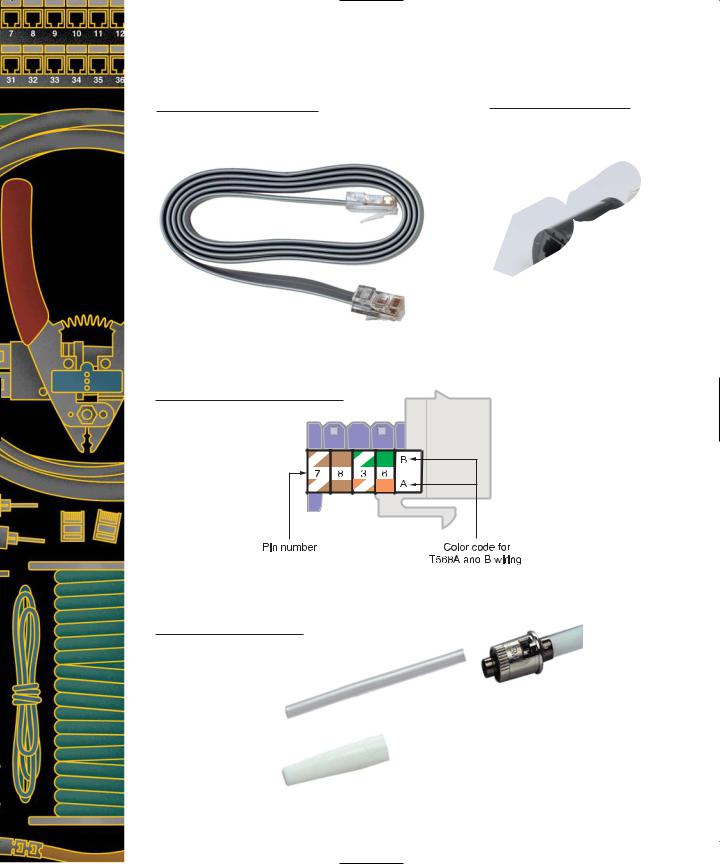
SILVER SATIN CABLE with an RJ-45 connector
MODULAR JACK THAT UTILIZES EITHER 568A OR 568B PINOUT CONFIGURATIONS
3M HOTMELT™ ST FIBER OPTIC CONNECTOR
TWIN-AXIAL CABLE TO RJ-11 BALUN
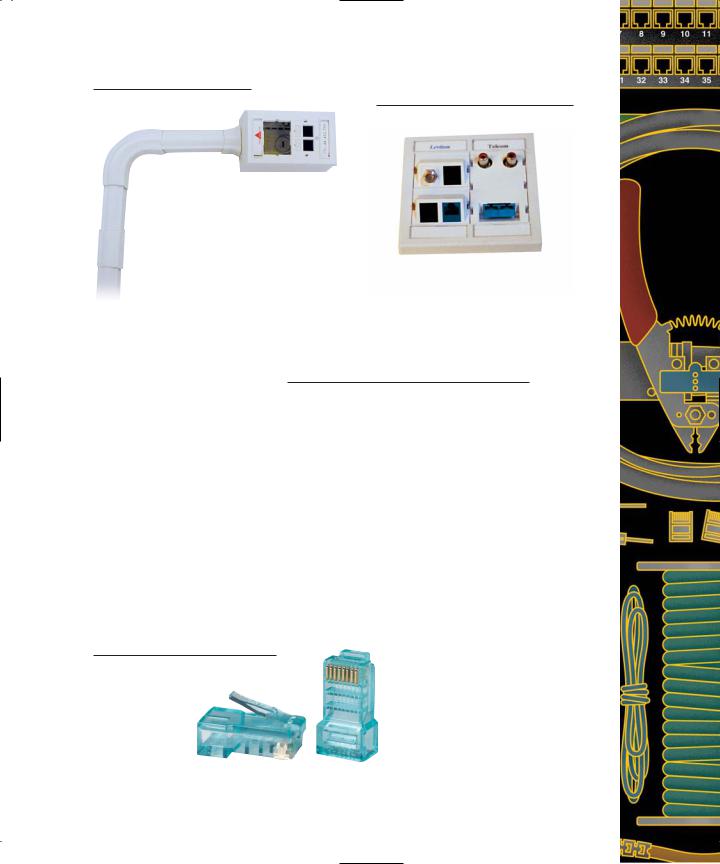
RACEWAY AND SURFACE MOUNT BOX
RJ-45 CRIMP-ON CONNECTOR
(Photo courtesy of The Siemon Company)
MODULAR WALL PLATE
with RJ-45, coaxial video, RCA, S-Video, and fiber optic connectors
CABLE WITH BOTH 110 AND RJ-45 ENDS
(Photo courtesy of The Siemon Company)
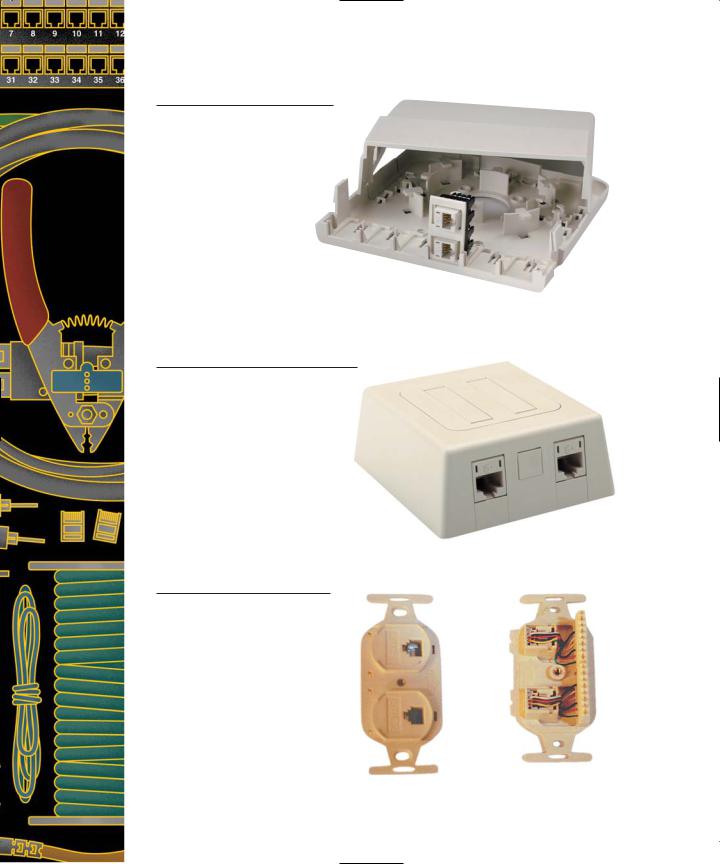
SURFACE-MOUNT, MODULAR MULTIMEDIA BOX
EXAMPLE OF A SURFACE-MOUNT BISCUIT JACK
FIXED-DESIGN, DUPLEX, RJ-45 WALL PLATE THAT USES 110 PUNCH-DOWNS
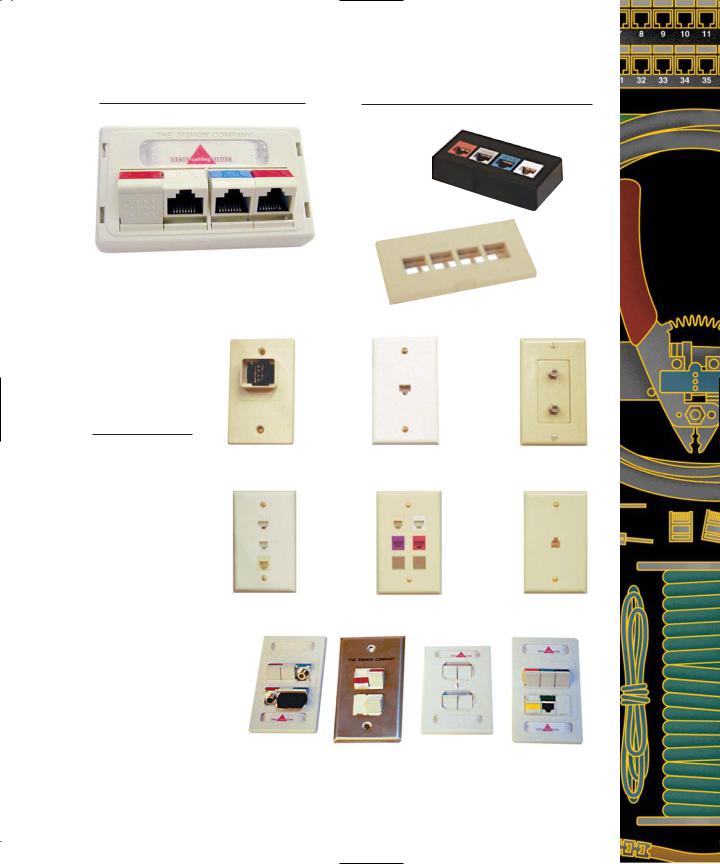
MODULAR FURNITURE WITH FOUR ANGLED JACKS
(one with a dust cover)
FIXED DESIGN WALL PLATES
A. Token Ring B. RJ-11
C. Dual cable TV (coax)
|
A |
|
WALL PLATES |
|
|
A. Modular 3 position |
|
|
with three RJ-45 jacks |
|
|
B. Modular with six |
|
|
RJ-45 jacks |
|
|
C. Fixed design with |
|
|
single RJ-45 jack |
|
|
D. A 6-port wall plate |
A |
|
filled with various types |
||
|
||
of multimedia jacks |
|
|
E. A 4-port metal wall |
|
|
plate |
|
|
F. A 4-port wall plate |
|
|
filled with RJ-45 jacks |
|
|
G. A 6-port wall plate |
|
|
filled with various types |
|
|
of RJ-45 jacks |
|
|
|
|
MODULAR FURNITURE FACEPLATES
both low profile (foreground) and normal (background)
B C
B C
D E F G
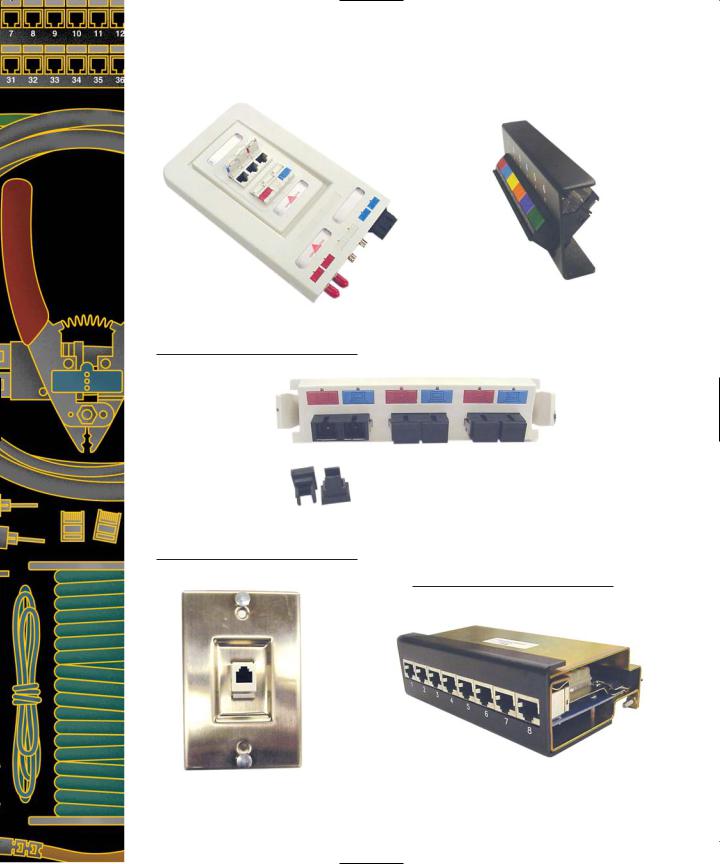
6A FIBER OPTIC WALL PLATE |
|
SIX-GANG, MODULAR FURNITURE |
SURROUND ADD-ON |
|
WALL PLATE WITH ANGLED JACKS |
|
|
|
DUAL SC CONNECTOR FIBER
PATCH PANEL
TELEPHONE WALL PLATE WITH MODULAR JACK
HEAVILY SHIELDED 110-TO-RJ-45 PUNCH-DOWN BLOCK
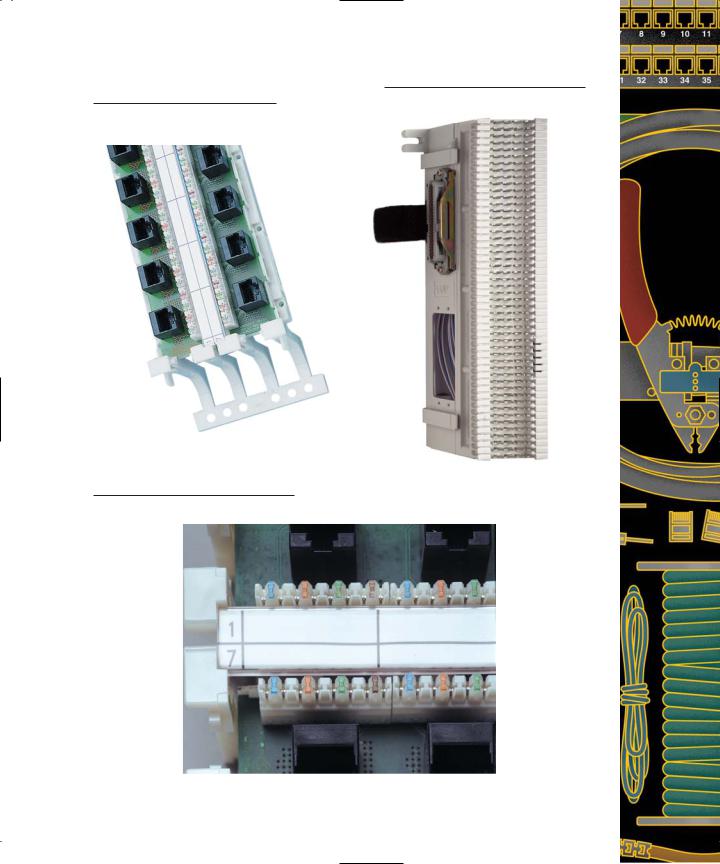
A 110-TO-RJ-45 PUNCH-DOWN
(Photo courtesy of The Siemon Company)
SIDE VIEW OF A 110 PUNCH-DOWN BLOCK
66-BLOCK WITH A 50-PAIR CABLE CONNECTOR
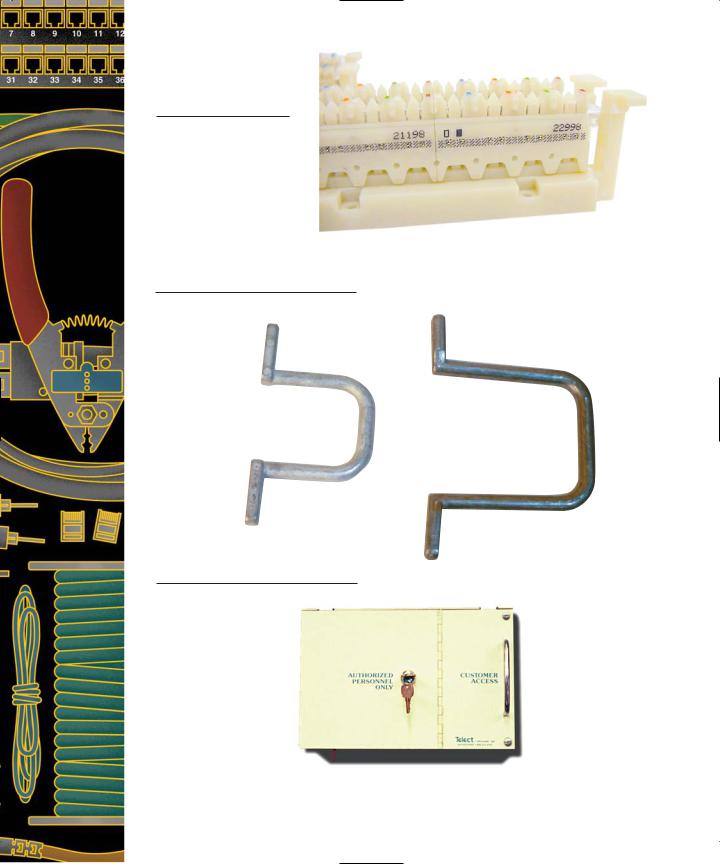
SIDE VIEW OF A 210 PUNCH-DOWN BLOCK
Note pairs are separated from each other.
CABLE MANAGEMENT D-RINGS
FIBER OPTIC BREAKOUT BOX

SAMPLE TELEPHONE INSTALLATION
Notice the 66blocks, biscuit jacks, PBX, cable management rings, and 50-pair cable connections.
(Photo courtesy of Computer Training Academy)
EXAMPLE OF A WIRING CLOSET WITH RACK-MOUNTED PATCH PANELS
(Photo courtesy of Computer Training Academy)

RACK WITH COLOR-CODED PATCH CORDS
(Photo courtesy of The Siemon Company)
50-PAIR UTP TELEPHONE CABLES TERMINATED TO THE BACK OF A 110-TO- RJ-45 RACK-MOUNT PATCH PANEL
(Photo courtesy of Computer Training Academy)
THE BACK OF A 110-TO-RJ-45 RACKMOUNTED PATCH PANEL
(Photo courtesy of Computer Training Academy)
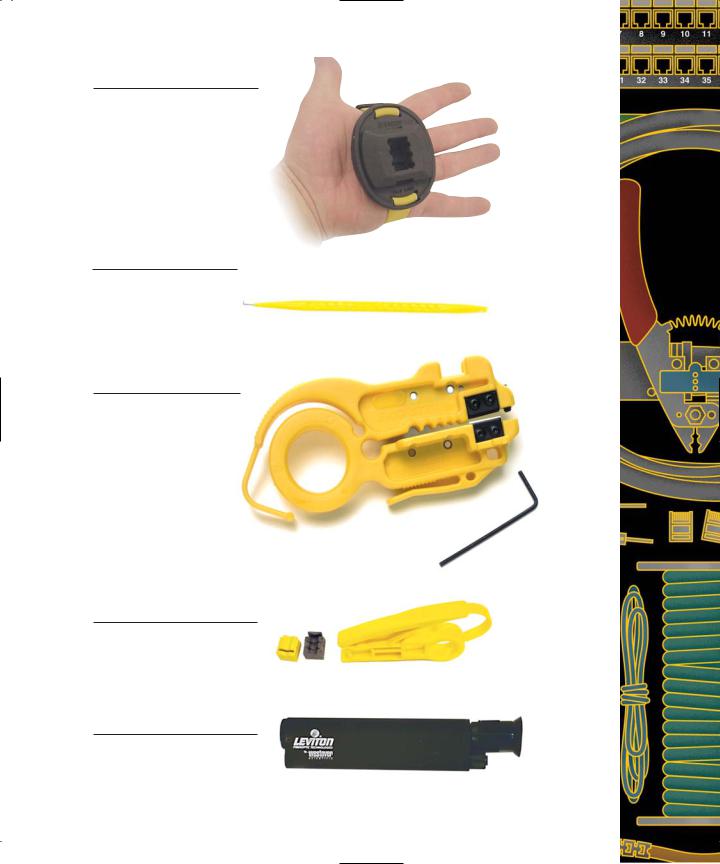
MODULAR JACK PUNCHDOWN AID ("PUCK")
ANGLED PICK PROBE
SIMPLE CABLE JACKET STRIPPER
CABLE STRIPPER WITH BOTH UTP AND COAX DIES
FIBER OPTIC TEST SCOPE
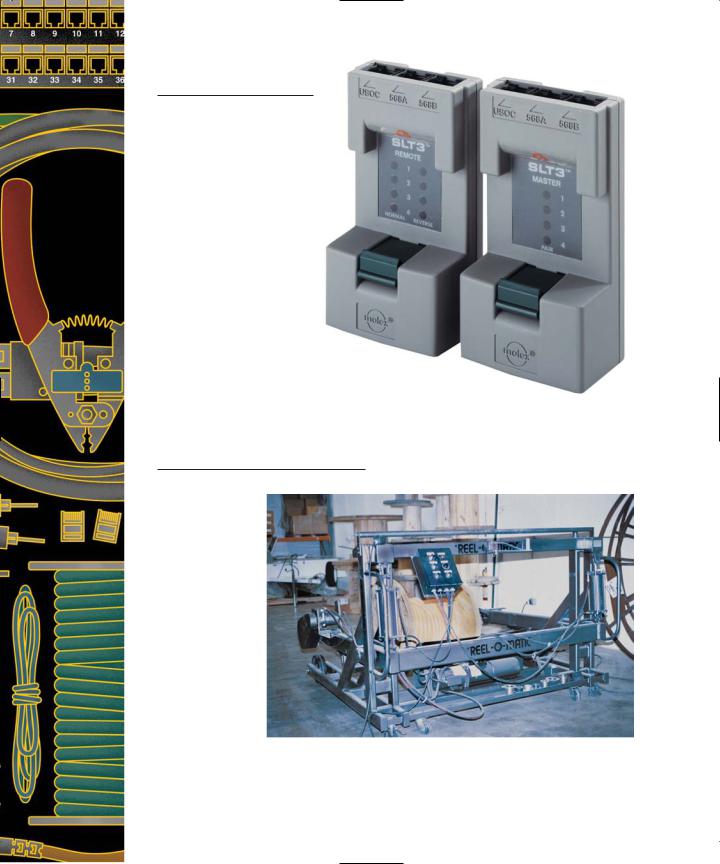
SIMPLE CABLE TESTER
TRACTOR-MOUNTED UNSPOOLER
for optical raceway used for outdoor installations
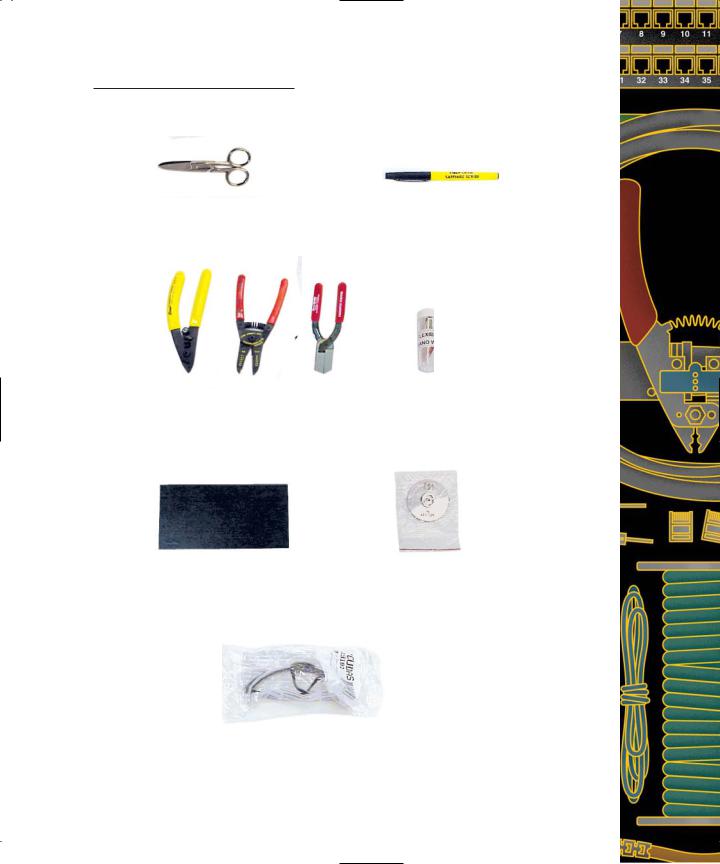
FIBER OPTIC CONNECTORIZING KIT
Kevlar shears |
Fiber scribing pen |
Fiber strippers |
Piano wire |
Polishing pad |
Polishing puck |
Goggles
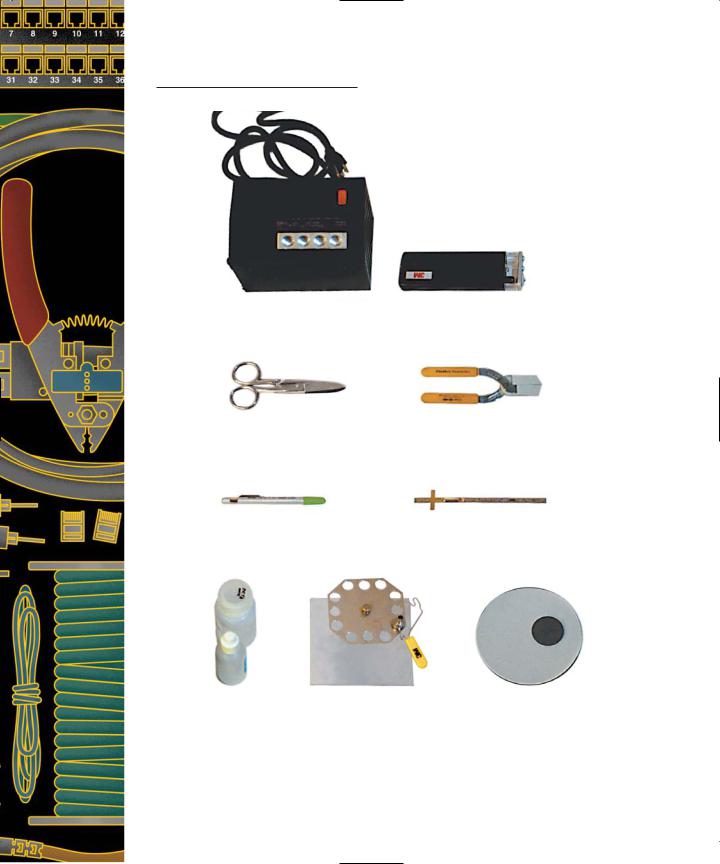
3M HOTMELT CONNECTORIZING KIT
Hotmelt™ oven |
Termination test scope |
Kevlar shears |
No-nick fiber stripper |
|
Scribe |
Measuring calipers |
|
Water bottle |
Connector cooling stand |
Polising puck and pad |
